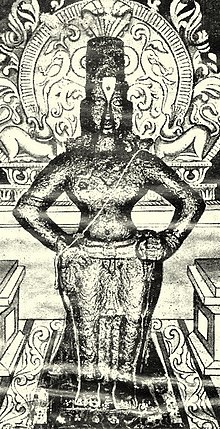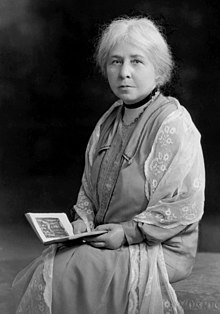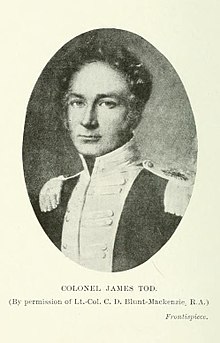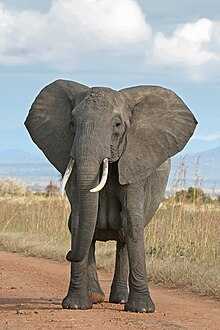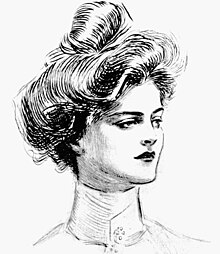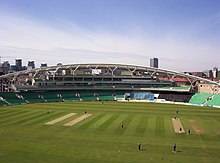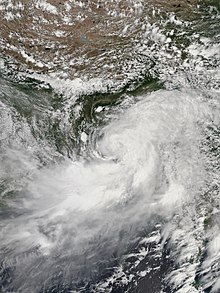Portal:India
Portal maintenance status: (June 2018)
|
Introduction


India, officially the Republic of India, is a country in South Asia. It is the seventh-largest country by area; the most populous country as of June 2023; and since its independence in 1947, the world's most populous democracy. Bounded by the Indian Ocean on the south, the Arabian Sea on the southwest, and the Bay of Bengal on the southeast, it shares land borders with Pakistan to the west; China, Nepal, and Bhutan to the north; and Bangladesh and Myanmar to the east. In the Indian Ocean, India is near Sri Lanka and the Maldives; its Andaman and Nicobar Islands share a maritime border with Thailand, Myanmar, and Indonesia. (Full article...)
 Featured article – show another
Featured article – show another
-
Image 1Portrait by Alexander Bassano, 1882
Victoria (Alexandrina Victoria; 24 May 1819 – 22 January 1901) was Queen of the United Kingdom of Great Britain and Ireland from 20 June 1837 until her death in 1901. Her reign of 63 years and 216 days—which was longer than those of any of her predecessors—constituted the Victorian era. It was a period of industrial, political, scientific, and military change within the United Kingdom, and was marked by a great expansion of the British Empire. In 1876, the British parliament voted to grant her the additional title of Empress of India.
Victoria was the daughter of Prince Edward, Duke of Kent and Strathearn (the fourth son of King George III), and Princess Victoria of Saxe-Coburg-Saalfeld. After the deaths of her father and grandfather in 1820, she was raised under close supervision by her mother and her comptroller, John Conroy. She inherited the throne aged 18 after her father's three elder brothers died without surviving legitimate issue. Victoria, a constitutional monarch, attempted privately to influence government policy and ministerial appointments; publicly, she became a national icon who was identified with strict standards of personal morality. (Full article...) -
Image 2
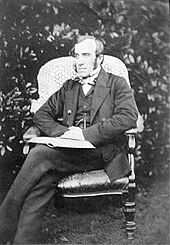
Monier Williams, elected as the second Boden Professor of Sanskrit in 1860; this photograph was taken by Lewis Carroll.
The election in 1860 for the position of Boden Professor of Sanskrit at the University of Oxford was a competition between two candidates offering different approaches to Sanskrit scholarship. One was Monier Williams, an Oxford-educated Englishman who had spent 14 years teaching Sanskrit to those preparing to work in British India for the East India Company. The other, Max Müller, was a German-born lecturer at Oxford specialising in comparative philology, the science of language. He had spent many years working on an edition of the Rig Veda (an ancient collection of Vedic Sanskrit hymns) and had gained an international reputation for his scholarship. Williams, in contrast, worked on later material and had little time for the "continental" school of Sanskrit scholarship that Müller exemplified. Williams regarded the study of Sanskrit as a means to an end, namely the conversion of India to Christianity. In Müller's opinion, his own work, while it would assist missionaries, was also valuable as an end in itself.
The election came at a time of public debate about Britain's role in India in the wake of the Indian Rebellion of 1857. Opinions were divided on whether greater efforts should be made to convert India or whether to remain sensitive to local culture and traditions. Both men battled for the votes of the electorate (the Convocation of the university, consisting of over 3,700 graduates) through manifestos and newspaper correspondence. Williams laid great stress in his campaign on the intention of the original founder of the chair, that the holder should assist in converting India through dissemination of the Christian scriptures. Müller's view was that his work on the Rig Veda was of great value for missionary work, and published testimonials accordingly. He also wanted to teach wider subjects such as Indian history and literature to assist missionaries, scholars, and civil servants – a proposal that Williams criticised as not in accordance with the original benefactor's wishes. The rival campaigns took out newspaper advertisements and circulated manifestos, and different newspapers backed each man. Although generally regarded as superior to Williams in scholarship, Müller had the double disadvantage (in the eyes of some) of being German and having liberal Christian views. Some of the newspaper pronouncements in favour of Williams were based on a claimed national interest of having an Englishman as Boden professor to assist with the work of governing and converting India. (Full article...) -
Image 3Keechaka Vadham (transl. The Extermination of Keechaka) is an Indian silent film produced, directed, filmed and edited by R. Nataraja Mudaliar. The first film to have been made in South India, it was shot in five weeks at Nataraja Mudaliar's production house, India Film Company. As the members of the cast were Tamils, Keechaka Vadham is considered to be the first Tamil film. No print of it is known to have survived, making it a lost film.
The screenplay, written by C. Rangavadivelu, is based on an episode from the Virata Parva segment of the Hindu epic Mahabharata, focusing on Keechaka's attempts to woo Draupadi. The film stars Raju Mudaliar and Jeevarathnam as the central characters. (Full article...) -
Image 4
The Indian roller (Coracias benghalensis) is a bird of the family Coraciidae. It is 30–34 cm (12–13 in) long with a wingspan of 65–74 cm (26–29 in) and weighs 166–176 g (5.9–6.2 oz). The face and throat are pinkish, the head and back are brown, with blue on the rump and contrasting light and dark blue on the wings and tail. The bright blue markings on the wing are prominent in flight. The sexes are similar in appearance. Two subspecies are recognised.
The Indian roller occurs widely from West Asia to the Indian subcontinent. Often found perched on roadside trees and wires, it is common in open grassland and scrub forest habitats, and has adapted well to human-modified landscapes. It mainly feeds on insects, especially beetles. The species is best known for the aerobatic displays of males during the breeding season. Adult males and females form pair bonds and raise the young together. The female lays 3–5 eggs in a cavity or crevice, which is lined with a thin mat of straw or feathers. The roller is the state bird of three Indian states. It is listed as a species of least concern on the IUCN Red List. (Full article...) -
Image 5

The Kingdom of Mysore was a geopolitical realm in southern India founded in around 1399 in the vicinity of the modern-day city of Mysore and prevailed until 1950, it is one of the few Indian polity to be ruled by both hindu and muslim kings. The territorial boundaries and the form of government transmuted substantially throughout the kingdom's lifetime. While originally a feudal vassal under the Vijayanagara Empire, it became a princely state in British Raj from 1799 to 1947, marked in-between by major political changes.
The kingdom, which was founded and ruled for the most part by the Wadiyars, initially served as a feudal vassal under the Vijayanagara Empire. With the gradual decline of the Empire, the 16th-century Timmaraja Wodeyar II declared independence from it. The 17th century saw a steady expansion of its territory and, during the rules of Narasaraja Wodeyar I and Devaraja Wodeyar II, the kingdom annexed large expanses of what is now southern Karnataka and parts of Tamil Nadu, becoming a formidable power in the Deccan. (Full article...) -
Image 6The central image at Vithoba Temple in Pandharpur
Vithoba (IAST: Viṭhobā), also known as Vitthala (IAST: Viṭṭhala), and Panduranga (IAST: Pāṇḍuraṅga), is a Hindu deity predominantly worshipped in the Indian states of Maharashtra and Karnataka. He is a form of the Hindu deity Vishnu in his avatar: Krishna. Vithoba is often depicted as a dark young boy, standing arms akimbo on a brick, sometimes accompanied by his consort Rakhumai.
Vithoba is the focus of an essentially monotheistic, non-ritualistic bhakti-driven Varkari faith in Maharashtra and the Haridasa sect established in Dvaita Vedanta in Karnataka. Vithoba Temple, Pandharpur is his main temple. Vithoba legends revolve around his devotee Pundalik who is credited for bringing the deity to Pandharpur, and around Vithoba's role as a saviour to the poet-saints of the Varkari faith. The Varkari poet-saints are known for their unique genre of devotional lyric, the abhang, dedicated to Vithoba and composed in Marathi. Other devotional literature dedicated to Vithoba includes the Kannada hymns of the Haridasa and the Marathi versions of the generic aarti songs associated with rituals of offering light to the deity. The most important festivals of Vithoba are held on Shayani Ekadashi in the month of Ashadha, and Prabodhini Ekadashi in the month of Kartika. (Full article...) -
Image 7Gemini (/dʒɛminɪ/) is a 2002 Indian Tamil-language crime action film written and directed by Saran with Pon Elango as assistant director. This film was produced by AVM Productions. The film stars Vikram in the main lead role, while Kiran Rathod, Murali, Kalabhavan Mani, Vinu Chakravarthy, Manorama and Thennavan portray significant roles. Based on gang wars in Chennai, the film delves into the lives of outlaws and the roles the police and society play in their rehabilitation and acceptance.
In early 2001, rival gangsters "Vellai" Ravi and Chera reformed themselves with the patronage of a police officer. Saran was inspired by this incident and scripted a story based on it. Production began shortly afterwards in December the same year and was completed by March 2002. The film was shot mainly at the AVM Studios in Chennai, while two song sequences were filmed in Switzerland. The film had cinematography by A. Venkatesh and editing by Suresh Urs while the soundtrack was scored by Bharadwaj. (Full article...) -
Image 8
Margaret Alice Murray FSA Scot FRAI (13 July 1863 – 13 November 1963) was an Anglo-Indian Egyptologist, archaeologist, anthropologist, historian, and folklorist. The first woman to be appointed as a lecturer in archaeology in the United Kingdom, she worked at University College London (UCL) from 1898 to 1935. She served as president of the Folklore Society from 1953 to 1955, and published widely over the course of her career.
Born to a wealthy middle-class English family in Calcutta, British India, Murray divided her youth between India, Britain, and Germany, training as both a nurse and a social worker. Moving to London, in 1894 she began studying Egyptology at UCL, developing a friendship with department head Flinders Petrie, who encouraged her early academic publications and appointed her junior lecturer in 1898. In 1902–03, she took part in Petrie's excavations at Abydos, Egypt, there discovering the Osireion temple and the following season investigated the Saqqara cemetery, both of which established her reputation in Egyptology. Supplementing her UCL wage by giving public classes and lectures at the British Museum and Manchester Museum, it was at the latter in 1908 that she led the unwrapping of Khnum-nakht, one of the mummies recovered from the Tomb of two Brothers – the first time that a woman had publicly unwrapped a mummy. Recognising that British Egyptomania reflected the existence of a widespread public interest in Ancient Egypt, Murray wrote several books on Egyptology targeted at a general audience. (Full article...) -
Image 9Mukerji promoting Hichki in 2018
Rani Mukerji (pronounced [raːni mʊkʰərdʒi]; born 21 March 1978) is an Indian actress who works in Hindi films. Noted for her versatility, she is the recipient of multiple accolades, including eight Filmfare Awards. Mukerji has featured in listings of the leading and highest-paid actresses of the 2000s.
Born into the Mukherjee-Samarth family, Mukerji dabbled with acting as a teenager by starring in her father Ram Mukherjee's Bengali-language film Biyer Phool and in the social drama Raja Ki Aayegi Baaraat (both 1996). Mukerji had her first commercial success with the action film Ghulam and breakthrough with the romance Kuch Kuch Hota Hai (both 1998). Following a brief setback, the year 2002 marked a turning point for her when she was cast by Yash Raj Films as the star of the drama Saathiya. (Full article...) -
Image 10Taare Zameen Par (lit. 'Stars on Earth'), also known as Like Stars on Earth in English, is a 2007 Indian Hindi-language drama film produced and directed by Aamir Khan. It stars Khan himself, with Darsheel Safary, Tanay Chheda, Vipin Sharma and Tisca Chopra. It explores the life and imagination of Ishaan (Safary), an artistically gifted 8-year-old boy whose poor academic performance leads his parents to send him to a boarding school, where a new art teacher Nikumbh (Khan) suspects that he is dyslexic and helps him to overcome his reading disorder. The film focuses on raising awareness about autism and psychiatric disability in children.
Creative director and writer Amole Gupte developed the idea with his wife Deepa Bhatia, who was the film's editor. Shankar–Ehsaan–Loy composed the score, and Prasoon Joshi wrote the lyrics for many of the songs. Principal photography took place in Mumbai, and in Panchgani's New Era High School, where some of the school's students participated in the filming. (Full article...) -
Image 11
Shah Rukh Khan (pronounced [ˈʃɑːɦɾʊx xɑːn] ⓘ; born 2 November 1965), also known by the initialism SRK, is an Indian actor and film producer who works in Hindi cinema. Referred to in the media as the "Baadshah of Bollywood" and "King Khan", he has appeared in more than 100 films, and earned numerous accolades, including 14 Filmfare Awards. He has been awarded the Padma Shri by the Government of India, as well as the Order of Arts and Letters and Legion of Honour by the Government of France. Khan has a significant following in Asia and the Indian diaspora worldwide. In terms of audience size and income, several media outlets have described him as one of the most successful film stars in the world. Many of his films thematise Indian national identity and connections with diaspora communities, or gender, racial, social and religious differences and grievances.
Khan began his career with appearances in several television series in the late 1980s and made his Bollywood debut in 1992 with the musical romance Deewana. He was initially recognised for playing villainous roles in the films Baazigar (1993) and Darr (1993). Khan established himself by starring in a series of top-grossing romantic films, including Dilwale Dulhania Le Jayenge (1995), Dil To Pagal Hai (1997), Kuch Kuch Hota Hai (1998), Mohabbatein (2000), Kabhi Khushi Kabhie Gham... (2001), Kal Ho Naa Ho (2003), Veer-Zaara (2004) and Kabhi Alvida Naa Kehna (2006). He earned critical acclaim for his portrayal of an alcoholic in the period romantic drama Devdas (2002), a NASA scientist in the social drama Swades (2004), a hockey coach in the sports drama Chak De! India (2007), and a man with Asperger syndrome in the drama My Name Is Khan (2010). Further commercial successes came with the romances Om Shanti Om (2007) and Rab Ne Bana Di Jodi (2008), and with his expansion to comedies in Chennai Express (2013) and Happy New Year (2014). Following a brief setback and hiatus, Khan made a career comeback with the 2023 action thrillers Pathaan and Jawan, both of which rank among the highest-grossing Indian films. (Full article...) -
Image 12Kal Ho Naa Ho (transl. Tomorrow may never come, pronounced [kəl ɦoː naː ɦoː]), also abbreviated as KHNH, is a 2003 Indian Hindi-language romantic comedy drama film directed by Nikhil Advani in his directorial debut with a story written by Karan Johar with dialogue by Niranjan Iyengar, and produced by Yash Johar. The film stars Shah Rukh Khan, Saif Ali Khan, and Preity Zinta, with Jaya Bachchan, Sushma Seth, Reema Lagoo, Lillete Dubey, and Delnaaz Irani in supporting roles. In the film, Naina Catherine Kapur (Zinta) and Aman Mathur (Shah Rukh Khan) fall in love, but a secret prevents him from reciprocating his feelings and results in a plan to set Naina up with her best friend, Rohit Patel (Saif Ali Khan).
Collaborating with Johar, Shankar–Ehsaan–Loy composed the soundtrack and score. Anil Mehta, Manish Malhotra, and Sharmishta Roy were the cinematographer, costume designer and art director, respectively. Principal photography took place in Toronto, New York City, and Mumbai from January to October 2003. The soundtrack was released on 27 September 2003 to positive reviews; the title song, "It's The Time To Disco", "Kuch To Hua Hai", and "Pretty Woman" were particularly well-received. (Full article...) -
Image 13The Legend of Bhagat Singh is a 2002 Indian Hindi-language biographical period film directed by Rajkumar Santoshi. The film is about Bhagat Singh, a revolutionary who fought for Indian independence along with fellow members of the Hindustan Socialist Republican Association. It features Ajay Devgan as the titular character along with Sushant Singh, D. Santosh and Akhilendra Mishra as the other lead characters. Raj Babbar, Farida Jalal and Amrita Rao play supporting roles. The film chronicles Singh's life from his childhood where he witnesses the Jallianwala Bagh massacre until the day he was hanged to death before the official trial dated 24 March 1931.
The film was produced by Kumar and Ramesh Taurani's Tips Industries on a budget of ₹200–250 million (about US$4.2–5.2 million in 2002). The story and dialogue were written by Santoshi and Piyush Mishra respectively, while Anjum Rajabali drafted the screenplay. K. V. Anand, V. N. Mayekar and Nitin Chandrakant Desai were in charge of the cinematography, editing and production design respectively. Principal photography took place in Agra, Manali, Mumbai and Pune from January to May 2002. The soundtrack and film score were composed by A. R. Rahman, with the songs "Mera Rang De Basanti" and "Sarfaroshi Ki Tamanna" being well received in particular. (Full article...) -
Image 14
Arthur Edward Jeune Collins (18 August 1885 – 11 November 1914) was an English cricketer and soldier. He held, for 116 years, the record of highest score in cricket: as a 13-year-old schoolboy, he scored 628 not out over four afternoons in June 1899. Collins's record-making innings drew a large crowd and increasing media interest; spectators at the Old Cliftonian match being played nearby were drawn away to watch the junior school house cricket match in which Collins was playing. Despite this achievement, Collins never played first-class cricket. Collins's 628 not out stood as the record score until January 2016 when an Indian boy, Pranav Dhanawade, scored 1009 in a single innings.
Collins joined the British Army in 1902 and studied at the Royal Military Academy, Woolwich, before becoming an officer in the Royal Engineers. He served in France during the First World War, where he was killed in action in 1914 during the First Battle of Ypres. Collins had been mentioned in despatches and also represented the Royal Military Academy at cricket and rugby union. (Full article...) -
Image 15Pather Panchali (pronounced [pɔtʰer pãtʃali] transl. Song of the Little Road) is a 1955 Indian Bengali-language drama film written and directed by Satyajit Ray in his directoral debut and produced by the Government of West Bengal. It is an adaptation of Bibhutibhushan Bandyopadhyay's 1929 Bengali novel of the same name and features Subir Banerjee, Kanu Banerjee, Karuna Banerjee, Uma Dasgupta, and Chunibala Devi in major roles. The first film in The Apu Trilogy, Pather Panchali depicts the childhood travails of the protagonist Apu and his elder sister Durga amid the harsh village life of their poor family.
The film was shot mainly on location, had a limited budget, featured mostly amateur actors, and was made by an inexperienced crew. Lack of funds led to frequent interruptions in production, which took nearly three years, but the West Bengal government pulled Ray out of debt by buying the film for the equivalent of $60,000, which it turned into a profit of $700,000 by 1980. The sitar player Ravi Shankar composed the film's soundtrack and score using classical Indian ragas. Subrata Mitra was in charge of the cinematography while editing was handled by Dulal Dutta. Following its premiere on 3 May 1955 during an exhibition at New York's Museum of Modern Art, Pather Panchali was released in Calcutta the same year to an enthusiastic reception. A special screening was attended by the Chief Minister of West Bengal and the Prime Minister of India. (Full article...) -
Image 16The frontispiece of the 1920 edition of Tod's Annals and Antiquities of Rajast'han
Lieutenant-Colonel James Tod (20 March 1782 – 18 November 1835) was an officer of the British East India Company and an Oriental scholar. He combined his official role and his amateur interests to create a series of works about the history and geography of India, and in particular the area then known as Rajputana that corresponds to the present day state of Rajasthan, and which Tod referred to as Rajast'han.
Tod was born in London and educated in Scotland. He joined the East India Company as a military officer and travelled to India in 1799 as a cadet in the Bengal Army. He rose quickly in rank, eventually becoming captain of an escort for an envoy in a Sindian royal court. After the Third Anglo-Maratha War, during which Tod was involved in the intelligence department, he was appointed Political Agent for some areas of Rajputana. His task was to help unify the region under the control of the East India Company. During this period Tod conducted most of the research that he would later publish. Tod was initially successful in his official role, but his methods were questioned by other members of the East India Company. Over time, his work was restricted and his areas of oversight were significantly curtailed. In 1823, owing to declining health and reputation, Tod resigned his post as Political Agent and returned to England. (Full article...) -
Image 17Osbert Guy Stanhope Crawford CBE FBA FSA (28 October 1886 – 28 November 1957) was a British archaeologist who specialised in the archaeology of prehistoric Britain and Sudan. A keen proponent of aerial archaeology, he spent most of his career as the archaeological officer of the Ordnance Survey (OS) and also wrote a range of books on archaeological subjects.
Born in Bombay, British India, to a wealthy middle-class Scottish family, Crawford moved to England as an infant and was raised by his aunts in London and Hampshire. He studied geography at Keble College, Oxford, and worked briefly in that field before devoting himself professionally to archaeology. Employed by the philanthropist Henry Wellcome, Crawford oversaw the excavation of Abu Geili in Sudan before returning to England shortly before the First World War. During the conflict he served in both the London Scottish Regiment and the Royal Flying Corps, where he was involved in ground and aerial reconnaissance along the Western Front. After an injury forced a period of convalescence in England, he returned to the Western Front, where he was captured by the German Army in 1918 and held as a prisoner of war until the end of the conflict. (Full article...) -
Image 18Mayabazar (transl. Market of illusions) is a 1957 Indian epic Hindu mythological film directed by K. V. Reddy. It was produced by Nagi Reddi and Chakrapani under their banner, Vijaya Productions. The film was shot simultaneously in Telugu and Tamil, with a few differences in the cast. The story is an adaptation of the folk tale Sasirekha Parinayam, which is based on the characters of the epic Mahabharata. It revolves around the roles of Krishna (N. T. Rama Rao) and Ghatotkacha (S. V. Ranga Rao), as they try to reunite Arjuna's son Abhimanyu (Telugu: Akkineni Nageswara Rao, Tamil: Gemini Ganesan) with his love, Balarama's daughter Sasirekha (Savitri). The Telugu version features Gummadi, Mukkamala, Ramana Reddy, and Relangi in supporting roles, with D. Balasubramaniam, R. Balasubramaniam, V. M. Ezhumalai, and K. A. Thangavelu playing those parts in the Tamil version.
The first mythological film produced by their studio, Mayabazar marked a milestone for Nagi Reddi and Chakrapani. In addition to the technical crew, 400 studio workers – including light men, carpenters, and painters – participated in the development of the film. Director Reddy was meticulous with the pre-production and casting phases, which took nearly a year to complete. Though Rama Rao was initially reluctant to play the lead role, his portrayal of Krishna received acclaim and yielded more offers to reprise the same role in several unrelated films. The soundtrack features twelve songs, with most of the musical score composed by Ghantasala. Telugu lyrics were written by Pingali Nagendrarao and Tamil lyrics were written by Thanjai N. Ramaiah Dass. One of those songs, Lahiri Lahiri, was accompanied by the first illusion of moonlight in Indian cinema, shot by cinematographer Marcus Bartley. (Full article...) -
Image 19A Bengal tigress in Kanha Tiger Reserve, India
The tiger (Panthera tigris) is a large cat and a member of the genus Panthera native to Asia. It has a powerful, muscular body with a large head and paws, a long tail and orange fur with black, mostly vertical stripes. It is traditionally classified into nine recent subspecies, though some recognise only two subspecies, mainland Asian tigers and the island tigers of the Sunda Islands.
Throughout the tiger's range, it inhabits mainly forests, from coniferous and temperate broadleaf and mixed forests in the Russian Far East and Northeast China to tropical and subtropical moist broadleaf forests on the Indian subcontinent and Southeast Asia. The tiger is an apex predator and preys mainly on ungulates, which it takes by ambush. It lives a mostly solitary life and occupies home ranges, defending these from individuals of the same sex. The range of a male tiger overlaps with that of multiple females with whom he mates. Females give birth to usually two or three cubs that stay with their mother for about two years. When becoming independent, they leave their mother's home range and establish their own. (Full article...) -
Image 20
Kalidas (pronounced [kaːɭidaːs] transl. The Servant of Kali) is a 1931 Indian biographical film directed by H. M. Reddy and produced by Ardeshir Irani. It is notable for being the first sound film in the Tamil and Telugu languages, and the first sound film to be made in a Dravidian language. It was based on the life of the Sanskrit poet Kalidasa, hence its namesake; it featured P. G. Venkatesan in the title role and T. P. Rajalakshmi as the female lead, with L. V. Prasad, Thevaram Rajambal, T. Susheela Devi, J. Sushila, and M. S. Santhanalakshmi in supporting roles.
Kalidas, principally in Tamil, contained additional dialogue in Telugu and Hindi. While Rajalakshmi spoke Tamil, Venkatesan spoke only Telugu due to his lack of fluency in Tamil, and Prasad spoke only Hindi. Despite its mythological theme, the film featured songs from much later time periods, such as the compositions of Carnatic musician Tyagaraja, publicity songs of the Indian National Congress, and songs about Mahatma Gandhi and the Indian independence movement. The sound was recorded using German-made technology. Kalidas was shot in Bombay on the sets of India's first sound film Alam Ara (1931) and was completed in eight days. (Full article...) -
Image 21A female African bush elephant in Mikumi National Park, Tanzania
Elephants are the largest living land animals. Three living species are currently recognised: the African bush elephant (Loxodonta africana), the African forest elephant (L. cyclotis), and the Asian elephant (Elephas maximus). They are the only surviving members of the family Elephantidae and the order Proboscidea; extinct relatives include mammoths and mastodons. Distinctive features of elephants include a long proboscis called a trunk, tusks, large ear flaps, pillar-like legs, and tough but sensitive grey skin. The trunk is prehensile, bringing food and water to the mouth and grasping objects. Tusks, which are derived from the incisor teeth, serve both as weapons and as tools for moving objects and digging. The large ear flaps assist in maintaining a constant body temperature as well as in communication. African elephants have larger ears and concave backs, whereas Asian elephants have smaller ears and convex or level backs.
Elephants are scattered throughout sub-Saharan Africa, South Asia, and Southeast Asia and are found in different habitats, including savannahs, forests, deserts, and marshes. They are herbivorous, and they stay near water when it is accessible. They are considered to be keystone species, due to their impact on their environments. Elephants have a fission–fusion society, in which multiple family groups come together to socialise. Females (cows) tend to live in family groups, which can consist of one female with her calves or several related females with offspring. The leader of a female group, usually the oldest cow, is known as the matriarch. (Full article...) -
Image 22Kaif promoting Bharat in 2019
Katrina Kaif (pronounced [kəˈʈriːna kɛːf]; born Katrina Turquotte, 16 July 1983) is a British actress who works in Hindi-language films. One of the highest-paid actresses in India, she has received accolades, including four Screen Awards and four Zee Cine Awards, in addition to three Filmfare nominations. Though reception to her acting has varied, she is noted for her action film roles and her dancing ability.
Born in British Hong Kong, Kaif lived in several countries before she moved to London for three years. She received her first modelling assignment as a teenager and later pursued a career as a fashion model. At a fashion show in London, Indian filmmaker Kaizad Gustad cast her in Boom (2003), a critical and commercial failure. While Kaif established a successful modelling career in India, she initially had difficulty finding film roles due to her poor command of Hindi. After appearing in the Telugu film Malliswari (2004), Kaif earned commercial success in Bollywood with the romantic comedies Maine Pyaar Kyun Kiya? (2005) and Namastey London (2007). Further success followed with a series of box-office hits, but she was criticised for her acting, repetitive roles, and inclination to male-dominated films. (Full article...) -
Image 23
The Chalukya dynasty ([tʃaːɭukjə]) was a Classical Indian dynasty that ruled large parts of southern and central India between the 6th and the 12th centuries. During this period, they ruled as three related yet individual dynasties. The earliest dynasty, known as the "Badami Chalukyas", ruled from Vatapi (modern Badami) from the middle of the 6th century. The Badami Chalukyas began to assert their independence at the decline of the Kadamba kingdom of Banavasi and rapidly rose to prominence during the reign of Pulakeshin II. After the death of Pulakeshin II, the Eastern Chalukyas became an independent kingdom in the eastern Deccan. They ruled from Vengi until about the 11th century. In the western Deccan, the rise of the Rashtrakutas in the middle of the 8th century eclipsed the Chalukyas of Badami before being revived by their descendants, the Western Chalukyas, in the late 10th century. These Western Chalukyas ruled from Kalyani (modern Basavakalyan) until the end of the 12th century.
The rule of the Chalukyas marks an important milestone in the history of South India and a golden age in the history of Karnataka. The political atmosphere in South India shifted from smaller kingdoms to large empires with the ascendancy of Badami Chalukyas. A Southern India-based kingdom took control and consolidated the entire region between the Kaveri and the Narmada rivers. The rise of this empire saw the birth of efficient administration, overseas trade and commerce and the development of new style of architecture called "Chalukyan architecture". Kannada literature, which had enjoyed royal support in the 9th century Rashtrakuta court found eager patronage from the Western Chalukyas in the Jain and Veerashaiva traditions. The 11th century saw the patronage of Telugu literature under the Eastern Chalukyas. (Full article...) -
Image 24

India, officially the Republic of India, is a country in South Asia. It is the seventh-largest country by area; the most populous country as of June 2023; and since its independence in 1947, the world's most populous democracy. Bounded by the Indian Ocean on the south, the Arabian Sea on the southwest, and the Bay of Bengal on the southeast, it shares land borders with Pakistan to the west; China, Nepal, and Bhutan to the north; and Bangladesh and Myanmar to the east. In the Indian Ocean, India is near Sri Lanka and the Maldives; its Andaman and Nicobar Islands share a maritime border with Thailand, Myanmar, and Indonesia.
Modern humans arrived on the Indian subcontinent from Africa no later than 55,000 years ago. Their long occupation, predominantly in isolation as hunter-gatherers, has made the region highly diverse, second only to Africa in human genetic diversity. Settled life emerged on the subcontinent in the western margins of the Indus river basin 9,000 years ago, evolving gradually into the Indus Valley Civilisation of the third millennium BCE. By 1200 BCE, an archaic form of Sanskrit, an Indo-European language, had diffused into India from the northwest. Its hymns recorded the dawning of Hinduism in India. India's pre-existing Dravidian languages were supplanted in the northern regions. By 400 BCE, caste had emerged within Hinduism, and Buddhism and Jainism had arisen, proclaiming social orders unlinked to heredity. Early political consolidations gave rise to the loose-knit Maurya and Gupta Empires. Widespread creativity suffused this era, but the status of women declined, and untouchability became an organized belief. In South India, the Middle kingdoms exported Dravidian language scripts and religious cultures to the kingdoms of Southeast Asia. (Full article...) -
Image 25Portrait by Charles Dana Gibson, c. 1903
Margaret Ives Abbott (June 15, 1878 – June 10, 1955) was an American amateur golfer. She was the first American woman to win an Olympic event: the women's golf tournament at the 1900 Summer Olympics.
Born in Calcutta (now Kolkata), British Raj, in 1878, Abbott moved with her family to Chicago in 1884. She joined the Chicago Golf Club in Wheaton, Illinois, where she received coaching from Charles B. Macdonald and H. J. Whigham. In 1899, she traveled with her mother to Paris to study art. The following year, along with her mother, she signed up for a women's golf tournament without realizing that it was the second modern Olympics. Abbott won the tournament with a score of 47 strokes; her mother tied for seventh place. Abbott received a porcelain bowl as a prize. (Full article...)
Selected pictures
-
Image 1Photograph credit: Charles James SharpThe pied bush chat (Saxicola caprata) is a small passerine bird widely distributed in Asia. The males are black with white shoulder and vent patches, while the females are predominantly brownish. This species is insectivorous, and like other chats hunts from a prominent low perch. This female pied bush chat was photographed in Pench National Park, India.
-
Image 2Photo: Muhammad Mahdi KarimThe glass house at Lal Bagh, a botanical garden in Bangalore, India. The garden was commissioned by the ruler of Mysore, Hyder Ali in 1760, and completed during the reign of his son Tipu Sultan. The glass house was modeled on London's Crystal Palace and constructed at the end of the 19th century.
-
Image 3The mosque at the Taj Mahal complex in Agra, India. This red sandstone building, on the western side of the complex, faces the west side of the mausoleum. In the forefront is a howz, meant for ablution. On the eastern side of the complex is the jawab ("answer"), a mirror image of the mosque except for the missing mihrab and different floor pattern; this jawab was mainly intended for architectural balance. Both were constructed in 1643.
-
Image 4Photograph: Muhammad Mahdi KarimBangles on display in Bangalore, India. These rigid bracelets are usually made from metal, wood, or plastic and are traditionally worn by women in India, Nepal, Pakistan, and Bangladesh. In India, it is a common tradition to see a new bride wearing glass bangles at her wedding and the honeymoon will end when the last bangle breaks.
-
Image 5Photo credit: Luc ViatourA fire breather in the "Jaipur Maharaja Brass Band" of India. Fire breathing, which is said to have originated in India, is the act of creating a large flame by spraying, with one's mouth, a flammable liquid upon an open flame. A number of legendary creatures are said to possess innate capabilities for fire breathing, most notably dragons.
-
Image 6Photograph: Muhammad Mahdi KarimA panoramic view of Bangalore from Corporation Circle, with UB City to the left and Richmond area to the right. Kanteerava Indoor Stadium is in the foreground. The third largest city in India, the city is known as the Silicon Valley of India for its numerous IT exports.
-
Image 7Photograph: Jorge RoyanAn Indian merchant holding green chickpeas (Cicer arietinum). One of the earliest cultivated legumes, chickpeas are ingredients in a number of dishes around the world. India is the largest producer of this nutrient-dense food, accounting for 64% of global production in 2016.
-
Image 8A potter at work in Jaura, Madhya Pradesh, India. Pottery, defined by ASTM International as "all fired ceramic wares that contain clay when formed, except technical, structural, and refractory products", originated during the Neolithic period.
-
Image 9Photograph: VengolisDanaus genutia, also known as the common tiger or striped tiger, is a species of butterfly found throughout India as well as Sri Lanka, Myanmar, South-East Asia and Australia. It is a member of the Danainae group of brush-footed butterflies. Both sexes have tawny wings with veins marked with broad black bands, and the male has a pouch on its hindwing. The butterfly is found in scrub jungles, fallow land adjacent to habitation, and deciduous forests, preferring areas of moderate to heavy rainfall. Its most common food plants in peninsular India are small herbs, twiners and creepers from the family Asclepiadaceae. The caterpillar of D. genutia obtains poison by eating poisonous plants, which make the caterpillar and butterfly taste unpleasant to predators. It has some 16 subspecies and although its evolutionary relationships are not completely resolved, it appears to be most closely related to the Malay tiger (D. affinis) and the white tiger.
-
Image 10Map credit: PlaneMadA map of Network of National Highways in India, including NHDP projects up to phase IIIB, which is due to be completed by December 2012. The National Highways are the main long-distance roadways and constitute a total of about 58,000 km (36,250 mi), of which 4,885 km (3,053 mi) are central-separated expressways. Highways in India are around 2% of the total road network in India, but carry nearly 40% of the total road traffic.
-
Image 11Photograph credit: Charles James SharpDanaus genutia, the common tiger or striped tiger, is a species of brush-footed butterfly found in Sri Lanka, India, Myanmar, south-eastern Asia and Australia. It prefers areas of moderate to heavy rainfall, and typical habitats include scrubby jungle, deciduous forests and fallow land near habitations. The insect sequesters toxins from plants, and advertises its unpalatability by having prominent markings and striking colour patterns. This adult male common tiger, of the subspecies D. g. genutia, was photographed in Kerala, India.
-
Image 12Photograph: Muhammad Mahdi KarimAlstroemeria × hybrida, an Alstroemeria hybrid, at the Lal Bagh Botanical Gardens in Bangalore, India. The genus consists of some 120 species and is native to South America.
-
Image 13Photograph credit: Muhammad Mahdi KarimThe Dharmaraya Swamy Temple is one of the oldest temples in Bangalore, India. It is thought to be more than 800 years old and is built in the Dravidian style, with a gopuram, an ornate monumental entrance tower. Gods worshipped here include Dharmaraya, Krishna, Arjuna, Draupadi and Bhima.
The Karaga festival starts from the temple each year; the festival is dedicated to Draupadi, the most important female character in the Hindu epic, the Mahabharata. Starting at midnight, a priest dressed as a woman carries an earthen pot filled with water and adorned with decorations several feet high on his head in procession through the town, preceded by hundreds of bare-chested, dhoti-clad, turbaned Veerakumaras bearing unsheathed swords. -
Image 14Photograph: Augustus BinuOdissi is an ancient classical dance that originated in the Hindu temples of Odisha, India. Historically, it has been performed predominantly by women, and expressed religious stories and spiritual ideas, particularly of Vaishnavism (Vishnu as Jagannath), but also of other traditions such as those related to Hindu gods Shiva and Surya, as well as Hindu goddesses (Shaktism). Modern Odissi productions by Indian artists have presented a diverse range of experimental ideas, culture fusion, themes and plays.
Odissi is learnt and performed as a composite of a basic dance motif called the Bhangas (symmetric body bends, stance). It involves the lower, mid, and upper body as three sources of perfecting expression and audience engagement with geometric symmetry and rhythmic musical resonance. -
Image 15Al-Ameen College of PharmacyPhoto: Muhammad Mahdi KarimAl-Ameen College of Pharmacy is a pharmacy college in Bangalore, India. Established in 1983, it is under the purview of the Al-Ameen Educational Society.
 Featured list – show another
Featured list – show another
-
Image 1The prime minister of India is the chief executive of the Government of India and chair of the Union Council of Ministers. Although the president of India is the constitutional, nominal, and ceremonial head of state, in practice and ordinarily, the executive authority is vested in the prime minister and their chosen Council of Ministers. The prime minister is the leader elected by the party with a majority in the lower house of the Indian parliament, the Lok Sabha, which is the main legislative body in the Republic of India. The prime minister and their cabinet are at all times responsible to the Lok Sabha. The prime minister can be a member of the Lok Sabha or of the Rajya Sabha, the upper house of the parliament. The prime minister ranks third in the order of precedence.
The prime minister is appointed by the president of India; however, the prime minister has to enjoy the confidence of the majority of Lok Sabha members, who are directly elected every five years, unless a prime minister resigns. The prime minister is the presiding member of the Council of Ministers of the Union government. The prime minister unilaterally controls the selection and dismissal of members of the council; and allocation of posts to members within the government. This council, which is collectively responsible to the Lok Sabha as per Article 75(3), assists the president regarding the operations under the latter's powers; however, by the virtue of Article 74 of the Constitution, such 'aid and advice' tendered by the council is binding. (Full article...) -
Image 2

Sanjiv Khanna, the incumbent chief justice of India, since 11 November 2024
The chief justice of India is the highest-ranking officer of the Indian judiciary and the chief judge of the Supreme Court of India. As head of the Supreme Court, the chief justice is responsible for the allocation of cases and appointment of constitutional benches which deal with important matters of law. In accordance with Article 145 of the Constitution of India and the Supreme Court Rules of Procedure of 1966, the chief justice allocates all work to the other judges.
A new chief justice is appointed by the president of India with recommendations by the outgoing chief justice in consultation with other judges. The chief justice serves in the role until they reach the age of sixty-five or are removed by the constitutional process of impeachment. As per convention, the name suggested by the incumbent chief justice is almost always the next senior-most judge in the Supreme Court. This convention has been broken twice: in 1973, Justice A. N. Ray was appointed superseding three senior judges and in 1977, Justice Mirza Hameedullah Beg was appointed as the chief justice superseding Justice Hans Raj Khanna. (Full article...) -
Image 3
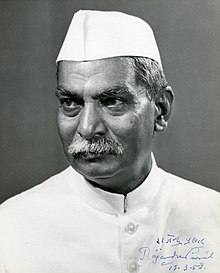
The president of India is the head of state of the Republic of India and the Supreme Commander of the Indian Armed Forces. The president is referred to as the first citizen of India. Although vested with these powers by the Constitution of India, the position is largely a ceremonial one and executive powers are de facto exercised by the prime minister.
The president is elected by the Electoral College composed of elected members of the parliament houses, the Lok Sabha and the Rajya Sabha, and also members of the Saasana Sabha or Vidhan Sabha, the state legislative assemblies. Presidents may remain in office for a tenure of five years, as stated by article 56, part V, of the Constitution of India. In the case where a president's term of office is terminated early or during the absence of the president, the vice president assumes office. By article 70 of part V, the parliament may decide how to discharge the functions of the president where this is not possible, or in any other unexpected contingency. (Full article...) -
Image 4India is a union consisting of 29 states and 9 union territories. As of 2024, with an estimated population of 1.484 billion, India is the world's most populous country. India occupies 2.4% of the world's area and is home to 17.5% of the world's population. The Indo-Gangetic Plain has one of the world's biggest stretches of fertile not-deep alluvium and are among the most densely populated areas of the world. The eastern and western coastal regions of Deccan Plateau are also densely populated regions of India. The Thar Desert in western Rajasthan is one of the most densely populated deserts in the world. The northern and north-eastern states along the Himalayas contain cold arid deserts with fertile valleys. These states have relatively low population density due to indomitable physical barriers. (Full article...)
-
Image 5

Members of the Indian cricket team before a Women's World Twenty20 game in Sydney, 2009
The India women's national cricket team represents India in international women's cricket. A full member of the International Cricket Council (ICC), the team is governed by the Board of Control for Cricket in India (BCCI). The India women's national cricket team first competed in 1976 when they played the West Indies in a six-match Test series at home. They recorded their first victory in the fourth match held at the Moin-ul-Haq Stadium, Patna; however, a loss in the sixth match led to the series being tied. India secured their first overseas victory in a one-off series against South Africa in 2002. As of October 2022[update], they have played 38 Test matches against five different opponents—Australia, England, South Africa, New Zealand and the West Indies. In terms of victories, they have been most successful against England and South Africa with two wins against each of them.
India played their first Women's One Day International cricket (WODI) match against England in the 1978 World Cup, which they hosted. They finished at the bottom of the table as they lost the remaining two games of the group stage. In the 1982 World Cup, they won their first ever WODI match when they beat the International XI by 79 runs at McLean Park, Napier. India's first overseas WODI series win came at the 1994–95 New Zealand Women's Centenary Tournament. They won the WODI series during their tour 1999 of England. They were the runner-up at the 2005 and the 2017 World Cup tournaments. As of October 2022[update], they have played 301 WODIs against twelve different opponents, and have the fourth highest number of victories (164) for any team in the format; They have recorded 81 wins and have been the fifth most successful team in the T20 format. Since their first Women's Twenty20 International (WT20I) against England in August 2006, India have played 151 matches. They have been most successful against Bangladesh with eleven wins against them. They were among the semi-finalists in the 2009 and 2010 ICC Women's World Twenty20 tournaments. (Full article...) -
Image 6

The chief minister of Jharkhand is the chief executive of the Indian state of Jharkhand. In accordance with the Constitution of India, the governor is a state's de jure head, but de facto executive authority rests with the chief minister. Following elections to the legislative assembly, the state's governor usually invites the party (or coalition) with a majority of seats to form the government. The governor appoints the chief minister, whose council of ministers are collectively responsible to the assembly. Given the confidence of the assembly, the chief minister's term is for five years and is subject to no term limits.
Seven people have served as the state's chief minister since Jharkhand's formation on 15 November 2000. Half of them, including the inaugural officeholder Babulal Marandi and Arjun Munda, represented the Bharatiya Janata Party (BJP). Hemant Soren, from the JMM, is the longest-serving chief minister. Three chief ministers, Shibu Soren, his son Hemant Soren, and Champai Soren, represented the Jharkhand Mukti Morcha (JMM). Shibu Soren's first term ended in just ten days, as he could not prove that he had the support of a majority of the house and was forced to resign. The state has also been governed by Madhu Koda, one of the few independents to become the chief minister of any state. In between their reigns, the state has also been under President's rule three times. Raghubar Das, of the BJP, was the first non-tribal and first chief minister to complete a full term in the state. Hemant Soren of the Jharkhand Mukti Morcha is the incumbent chief minister. (Full article...) -
Image 7

The Wanderers Stadium, Johannesburg, where India played their first ever Twenty20 International
A Twenty20 International (T20I) is a form of cricket match between two representative teams, each having T20I status as determined by the International Cricket Council (ICC), and is played under the rules of Twenty20 cricket. The first such match was played between Australia and New Zealand on 17 February 2005. The Indian cricket team played its first T20I match—under the captaincy of Virender Sehwag—during the 2006–07 series in South Africa; India defeated the hosts by six wickets in the one-off match and claimed the series.
As of July 2024, 115 players have represented India in T20Is. India won the inaugural edition of the ICC World Twenty20, defeating Pakistan in the final by five runs. (Full article...) -
Image 8

Kapoor in 2022
Ranbir Kapoor is an Indian actor who appears in Hindi films. He worked as an assistant director on the films Aa Ab Laut Chalen (1999) and Black (2005), before making his acting debut opposite Sonam Kapoor in Sanjay Leela Bhansali's romantic drama Saawariya (2007). It earned Kapoor the Filmfare Award for Best Male Debut. He established himself in 2009 with leading roles in three films—the coming-of-age drama Wake Up Sid, the comedy Ajab Prem Ki Ghazab Kahani and the drama Rocket Singh: Salesman of the Year. He won the Filmfare Critics Award for Best Actor for his combined work in these three films. In 2010, Kapoor played a character based on Arjuna and Michael Corleone in the commercially successful political thriller Raajneeti.
From 2011 to 2013, Kapoor's releases were among the highest-grossing Hindi films of their respective years. In Imtiaz Ali's musical Rockstar (2011), he played an aspiring singer, and in Anurag Basu's comedy-drama Barfi! (2012), he starred as a joyful deaf and mute man. His performance in both films was critically acclaimed and he earned two consecutive Best Actor awards at Filmfare and the former also earned him a Filmfare Critics Award for Best Actor. The romantic comedy Yeh Jawaani Hai Deewani (2013) further established him as a star. (Full article...) -
Image 9
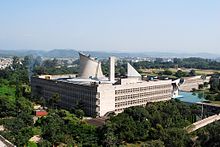
The Punjab Legislative Assembly is the unicameral state legislature of Punjab state in North India. The seat of the Legislative Assembly is at Chandigarh, the capital of the state. It is housed within the Chandigarh Capitol Complex, a World Heritage Site designed by Le Corbusier. The term of the assembly is five years, unless it is dissolved earlier. Since 1977, it has had 117 members who are directly elected, from single-seat constituencies.
Since the independence of India, the Scheduled Castes (SC) and Scheduled Tribes (ST) have been given Reservation status, guaranteeing political representation, and the Constitution lays down the general principles of positive discrimination for SCs and STs. The 2011 census of India stated that there were no people of any Scheduled Tribes in Punjab, while the Scheduled Castes constituted a significant portion of the population of the state, at 31.9%. The Scheduled Castes have been granted a reservation of 34 seats in the assembly. (Full article...) -
Image 10
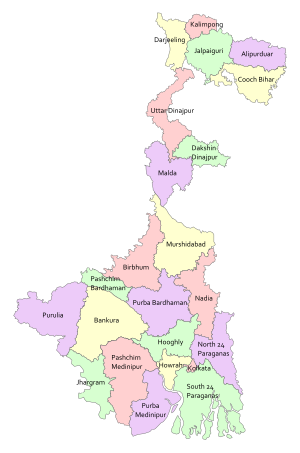
Districts of West Bengal
The Himalayas lies in the north of West Bengal and the Bay of Bengal is at the south. Between them, the river Ganga flows eastwards and its main distributary, the Hooghly River, flows south to reach the Bay of Bengal. The Siliguri Corridor, which connects North-East India with rest of the India, lies in the North Bengal region of the state. Geographically, West Bengal is divided into a variety of regions—Darjeeling Himalayan hill region, Terai and Dooars region, North Bengal plains, Rarh region, Western plateau and high lands, coastal plains, Sundarbans and the Ganga Delta.
In 1947, when India gained independence, the state of West Bengal was formed, with 14 districts, as per partition plan of the then Bengal province of British India. The former princely state Koch Bihar joined as a district on 26 January 1950, and the former French enclave Chandannagore joined as part of the Hooghly district in 1954. The States Reorganisation Act of 1956 led to addition of Purulia district to the state and to enlargement of West Dinajpur district. Later, larger districts such as West Dinajpur, 24 Parganas and Midnapore were bifurcated. (Full article...) -
Image 11

James Faulkner is one of the only four bowlers to take multiple five-wicket hauls and the only to take multiple five-wicket hauls in the same season.
In cricket, a five-wicket haul (also known as a "five-for" or "fifer") refers to a bowler taking five or more wickets in a single innings. This is regarded as a notable achievement, especially in T20 cricket where a bowler can bowl a maximum of only 24 balls (4 overs). The Indian Premier League (IPL) is a professional Twenty20 cricket league in India, which has been held annually since its first season in 2008. So far, 34 five-wicket hauls have been taken by different bowlers, of which only two five-wicket hauls have been taken outside India. Players from twelve of the thirteen teams have taken five-wicket hauls; Kochi Tuskers Kerala is the only franchise for which a player has not taken a five-wicket haul.
The first five-wicket haul was taken by Sohail Tanvir of the Rajasthan Royals against the Chennai Super Kings on 4 May 2008. He finished the game with 6 wickets. The most economical five-wicket haul was taken by Akash Madhwal of the Mumbai Indians, who claimed five wickets with an economy rate of 1.43 in the 2023 season. Yuzvendra Chahal of the Rajasthan Royals took the least economical five-wicket haul, 5/40 bowling with an economy rate of 10.00 in 2021. Anil Kumble is the oldest bowler to take a five-wicket haul, achieving the feat at the age of 38, while Jaydev Unadkat is the youngest, he was 21 when he took his first five-for in 2013. (Full article...) -
Image 12In cricket, a batsman reaches a triple century if they score 300 or more runs in a single innings. The Ranji Trophy is the premier first-class cricket championship played in India. Conducted by the Board of Control for Cricket in India, it was founded in 1934 as "The Cricket Championship of India". As of January 2020[update], a triple century has been scored on 46 occasions by 41 different batsmen in the Ranji Trophy.
The first triple century in the Ranji Trophy was scored by Maharashtra's Vijay Hazare against Baroda in the 1939–40 season. As of November January 2023[update], the most recent triple century in the tournament was scored by Prithvi Shaw from Mumbai, who made 379 against Assam in the 2022–23 season. The highest score in the competition was made by B. B. Nimbalkar, who scored 443 runs not out for Maharashtra against Kathiawar in the 1948–49 season. It is the only instance of a quadruple century in the tournament. The highest number of triple centuries are scored by Ravindra Jadeja, who has reached the milestone three times while playing for Saurashtra. Jadeja is followed by V. V. S. Laxman, Cheteshwar Pujara, and Wasim Jaffer, with two triple centuries each. Tamil Nadu's Woorkeri Raman and Arjan Kripal Singh are the only two batsmen to score triple centuries in the same innings. As of December 2016[update], five batsmen have scored 290–299 runs in an innings, and three of them were not out. (Full article...) -
Image 13

Tabu at an event for De De Pyaar De in 2019
Indian actress Tabu appears primarily in Hindi, Telugu, and Tamil films. Her first credited role came as a teenager in Dev Anand's Hum Naujawan (1985), and her first major role was in the Telugu film Coolie No. 1 (1991). In 1994, Tabu received the Filmfare Award for Best Female Debut for the Hindi action drama Vijaypath, which marked her first of many collaborations with co-star Ajay Devgn. The year 1996 was key for Tabu. Her performance as a young woman affected by the Punjab insurgency in Gulzar's Maachis proved to be a breakthrough, winning her the National Film Award for Best Actress. Also that year, Tabu won the Filmfare Award for Best Actress – Telugu for the romance Ninne Pelladata, and featured alongside Govinda in the comedy film Saajan Chale Sasural.
Tabu had a brief role in the war film Border, the highest-grossing Hindi film of 1997, and portrayed a village girl opposite Anil Kapoor in the Priyadarshan-directed drama Virasat. Among her 1999 releases were two of the top-grossing Bollywood films of the year—the comedy Biwi No.1, and the family drama Hum Saath-Saath Hain. She also starred as the rebellious daughter of a corrupt politician in Gulzar's critically praised drama Hu Tu Tu (1999). The following year, she starred in Kandukondain Kandukondain, a Tamil adaptation of Sense and Sensibility, and played a submissive homemaker in the bilingual drama Astitva. Tabu garnered a second National Film Award for Best Actress for portraying a bar dancer in Madhur Bhandarkar's crime drama Chandni Bar (2001). In 2003, she starred in the Bengali film Abar Aranye, and portrayed a character based on Lady Macbeth, in Maqbool—an adaptation of Macbeth from Vishal Bhardwaj. Following a few commercial failures, Tabu played triple roles in M. F. Husain's musical drama Meenaxi: A Tale of Three Cities. Tabu's first international project came with Mira Nair's adaptation of Jhumpa Lahiri's novel The Namesake. In R. Balki's Cheeni Kum (2007), Tabu starred alongside Amitabh Bachchan as a woman romantically involved with a much older man; the role earned her a record fourth Filmfare Critics Award for Best Actress. (Full article...) -
Image 14
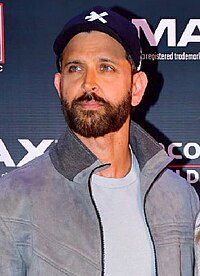
Roshan in 2024
Hrithik Roshan is an Indian actor known for his work in Hindi-language films. As a child, he made uncredited appearances in three films directed by his maternal grandfather, J. Om Prakash, the first of which was in Aasha (1980). In 1986, Roshan played the adopted son of Rajinikanth's character in Prakash's crime drama Bhagwaan Dada. Roshan subsequently worked as an assistant director on four films, including Khudgarz (1987) and Karan Arjun (1995), all of which were directed by his father, Rakesh.
Roshan's first leading role came opposite Ameesha Patel in Kaho Naa... Pyaar Hai (2000), a highly successful romantic drama directed by his father, for which he won two Filmfare Awards—Best Male Debut and Best Actor. In 2001, Roshan played a supporting role in Karan Johar's lucrative ensemble melodrama Kabhi Khushi Kabhie Gham.... This initial success was followed by roles in a series of critical and commercial failures, including Aap Mujhe Achche Lagne Lage (2002) and Main Prem Ki Diwani Hoon (2003), leading critics to believe that Roshan's career was over. His career prospects improved in 2003 when he played the role of a mentally disabled teenager in his father's science fiction film Koi... Mil Gaya. The film emerged as one of the highest-grossing Bollywood film of that year and earned Roshan the Best Actor – Critics and the Best Actor awards at Filmfare. His next release, the war drama Lakshya (2004), performed poorly at the box office despite earning positive reviews. (Full article...) -
Image 15

Asin in 2012
Asin is a former Indian actress who is known for her work in Tamil, Telugu and Hindi language films. She made her acting debut at the age of 15 in the Malayalam-language satirical comedy-drama Narendran Makan Jayakanthan Vaka in 2001. Asin had her first commercial success with the Telugu film Amma Nanna O Tamila Ammayi (2003). For her performance as a Tamil girl in the film, she received the Filmfare Best Telugu Actress Award. In the same year she won the Santosham Best Actress Award for her role in Telugu film Sivamani. In her next two Telugu releases: Lakshmi Narasimha (2004) and Gharshana (2004), Asin played the love interest of a police officer. Lakshmi Narasimha was a commercial success, while Gharshana received mixed reviews from critics but later gained a cult following.
She made her debut in Tamil cinema in the 2004 sports drama M. Kumaran Son of Mahalakshmi, a commercial success. The 2005 action thriller Ghajini marked a turning point in her career. Her role as a vivacious young model named Kalpana won her the Filmfare Best Tamil Actress Award. This led to a series of lead roles in commercially successful films, including the action film Sivakasi (2005), the thriller Varalaru (2006), the action thriller Pokkiri (2007), the action drama Vel (2008) and the science fiction film Dasavathaaram (2008), which established her as a leading actress of Tamil cinema. (Full article...) -
Image 16
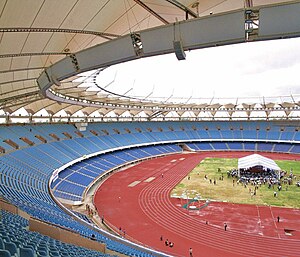
Jawaharlal Nehru Stadium as it appeared in July 2010, was the main venue for the 1982 Asiad.
The 1982 Asian Games (also known as the IX Asiad)[a] was a multi-sport event held in Delhi, India, from 12 November to 4 December 1982. A total of 3,411 athletes from 33 National Olympic Committees (NOCs) participated in these games, competing in 147 events in 21 sports and 22 disciplines. The number of participating countries was the greatest in Asian Games history. Sport events of handball, equestrian, rowing and golf were included for the first time; while fencing and bowling were excluded. This medal table ranks the participating NOCs by the number of gold medals won by their athletes.
Athletes from 23 participating NOCs won at least one medal; athletes from 16 of these NOCs secured at least one gold. Athletes from China won 61 gold medals, the most of any nation at these Asiad, and led the gold-medal count for the first time in their Asiad history. Japan had won the greatest number of medals in previous editions of the Games. China first competed at the Asian Games in 1974, in Tehran, where it finished third. Athletes from both China and Japan won the most total medals with 153. China has secured the top medal spot in every Asiad since 1982. South Korea finished third in total medals. North Korea finished fifth in total medals, and fourth in the gold-medal count. Host nation India finished the games with 57 medals overall (13 gold, 19 silver and 25 bronze, its best performance since 1951), in fifth spot in terms of total gold medals. (Full article...) -
Image 17The 2022 recipient: Pavan Malhotra
The National Film Award for Best Actor in a Supporting Role (known as National Film Award for Best Supporting Actor prior to 69th NFA) is an honour presented annually at India's National Film Awards ceremony by the National Film Development Corporation of India (NFDC), an organisation set up by the Indian Ministry of Information and Broadcasting. A national panel appointed annually by the NFDC selects the actor who has given the best performance in a supporting role within Indian cinema. The award is presented by the President of India at a ceremony held in New Delhi. Since the 70th National Film Awards, the name was changed to "Best Actor in a Supporting Role".
The winner is given a "Rajat Kamal" (Silver Lotus) certificate and a cash prize of ₹2 lakh (US$2,300). Including ties and repeat winners, the government of India has presented a total of 32 Best Supporting Actor awards to 29 different actors. Although Indian cinema produces films in more than 20 languages, the actors whose performances have won awards have worked in one or more of seven major languages: Hindi (18 awards), Tamil (9 awards), Bengali (3 awards), Malayalam (4 awards), Marathi (3 awards), Telugu (1 award), Kannada (1 award). (Full article...) -
Image 18

M. G. Ramachandran in Mohini (1948)
M. G. Ramachandran (17 January 1917 – 24 December 1987), popularly known by his initials "MGR", was an Indian actor, film director and film producer who had an extensive career primarily in Tamil language films. After starring in numerous commercially successful films from the 1950s to the early 1970s, he has continued to hold a matinée idol status in Tamil Nadu. Ramachandran made his debut in Ellis R. Dungan's 1936 film Sathi Leelavathi, where he played a police inspector. He followed it with a string of minor appearances and supporting roles in many films, notably Ashok Kumar (1941), where he played the general of emperor Ashoka's army, and as a captain in Dungan's Meera (1945).
Ramachandran's breakthrough came with his first lead role in A. S. A. Sami's swashbuckler film Rajakumari (1947) where he played a villager who marries a princess. Based on the Arabian Nights, Rajakumari was a commercially successful venture. He established himself as an action hero akin to Errol Flynn and Douglas Fairbanks in Tamil cinema with Manthiri Kumari (1950) and Marmayogi (1951). Both films had political undertones which earned Ramachandran a Robin Hood persona of being a champion for the downtrodden. His performance as the caring brother Rajendran who tries to keep his family together in En Thangai (1952) earned him critical acclaim. In 1953, he made his debut in Malayalam films opposite B. S. Saroja in Genova. Ramachandran continued to play roles which enabled him to adopt his ideas of fighting injustice meted out to the poor such as an outlaw in Malaikkallan (1954), and Nadodi Mannan (1958). In the latter, he featured in dual roles, as a king and a commoner, for the first time in his career. Both Malaikkallan and Nadodi Mannan were commercially successful, becoming the highest-grossing films of their respective release years. In addition to social dramas, Ramachandran received positive feedback and commercial success for swashbuckler films such as Alibabavum 40 Thirudargalum (1956), the first South Indian full-length colour film, Madurai Veeran (1956), Chakravarthi Thirumagal and Mahadevi (both released in 1957). (Full article...) -
Image 19
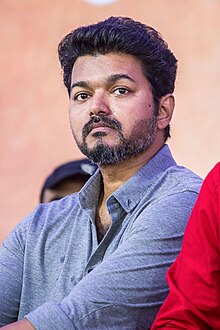
Vijay in 2018 in Nadigar Sangam Protest
Vijay is an Indian actor, playback singer and politician who works in Tamil cinema. He made his cinematic debut in 1984 with Vetri, directed by his father, S. A. Chandrasekhar. After appearing in Chandrasekhar's films as a child artist, Vijay made his debut as a lead actor with Naalaiya Theerpu (1992) at the age of 18. He followed it with a role opposite Vijayakanth in Senthoorapandi (1993). Vijay went on to play lead roles in his father's directorial ventures such as Rasigan(1994) and Deva (1995)Vishnu Most of those films were successful commercially.
Vijay's first commercial blockbuster was romcom Coimbatore Mappillai in 1996, followed by his breakthrough blockbuster romance film, Poove Unakkaga. His subsequent films, Love Today (1997) and Kadhalukku Mariyadhai (1997), were critically and commercially successful. His performance in the latter won him the Tamil Nadu State Film Award for Best Actor. Thulladha Manamum Thullum (1999), where he played a passionate singer gained him the reputation of a romantic hero. (Full article...) -
Image 20

The Padma Bhushan is the third-highest civilian award of the Republic of India. Instituted on 2 January 1954, the award is given for "distinguished service of a high order", without distinction of race, occupation, position, or sex. The recipients receive a Sanad, a certificate signed by the President of India and a circular-shaped medallion with no monetary association. The recipients are announced every year on Republic Day (26 January) and registered in The Gazette of India—a publication used for official government notices and released weekly by the Department of Publication, under the Ministry of Urban Development. The conferral of the award is not considered official without its publication in the Gazette. The names of recipients whose awards have been revoked or restored, both of which processes require the authority of the president, are archived and they are required to surrender their medal when their name is struck from the register; none of the conferments of Padma Bhushan during 2000–2009 have been revoked or restored. The recommendations are received from all the state and the union territory governments, as well as from Ministries of the Government of India, the Bharat Ratna and the Padma Vibhushan awardees, the Institutes of Excellence, the Ministers, the Chief Ministers and the Governors of State, and the Members of Parliament including private individuals.
When instituted in 1954, the Padma Bhushan was classified as "Dusra Varg" (Class II) under the three-tier Padma Vibhushan awards, which were preceded by the Bharat Ratna in hierarchy. On 15 January 1955, the Padma Vibhushan was reclassified into three different awards as the Padma Vibhushan, the Padma Bhushan and the Padma Shri. The criteria included "distinguished service of a high order in any field including service rendered by Government servants", but excluded those working with the public sector undertakings with the exception of doctors and scientists. The 1954 statutes did not allow posthumous awards; this was subsequently modified in the January 1955 statute. The design was also changed to the form that is currently in use; it portrays a circular-shaped toned bronze medallion 1+3⁄4 inches (44 mm) in diameter and 1⁄8 inch (3.2 mm) thick. The centrally placed pattern made of outer lines of a square of 1+3⁄16 inches (30 mm) side is embossed with a knob carved within each of the outer angles of the pattern. A raised circular space of diameter 1+1⁄16 inches (27 mm) is placed at the centre of the decoration. A centrally located lotus flower is embossed on the obverse side of the medal and the text "Padma" is placed above and the text "Bhushan" is placed below the lotus written in Devanagari script. The State Emblem of India is displayed in the centre of the reverse side, together with the national motto of India, "Satyameva Jayate" (Truth alone triumphs) in Devanagari script, which is inscribed on the lower edge. The rim, the edges and all embossing on either side is of standard gold with the text "Padma Bhushan" of gold gilt. The medal is suspended by a pink riband 1+1⁄4 inches (32 mm) in width with a broad white stripe in the middle. It is ranked fifth in the order of precedence of wearing of medals and decorations of the Indian civilian and military awards. (Full article...) -
Image 21
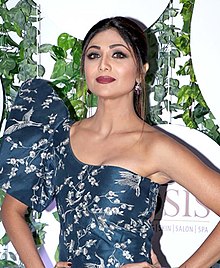
Shetty in 2018
Shilpa Shetty is an Indian actress who is primarily known for her work in Hindi films, in addition to a few Telugu, Kannada and Tamil films. Shetty made her acting debut opposite Shah Rukh Khan in the 1993 thriller Baazigar. Shetty's performance earned her two Filmfare Awards nominations for Lux New Face of the Year and Best Supporting Actress. She subsequently earned recognition with dual roles in the 1994 action-comedy Main Khiladi Tu Anari. After initial success, Shetty's films fared poorly at the box office for the next five years. Films Shetty starred in including action drama Aag, romantic drama Aao Pyaar Karen, comedy Haathkadi and Chhote Sarkar proved to be financially unsuccessful.
The 2000 romantic drama Dhadkan marked a turning point in her career, earning her several nominations in the Best Actress category at various award ceremonies. Shetty played the lead female in films such as family drama Apne, police drama Garv: Pride and Honour and musical drama Life in a... Metro. Her comic performance as an eccentric fisherwoman in 2002 action-drama release Rishtey earned her a nomination for the Filmfare Best Supporting Actress Award. Shetty became a global figure after winning the 2007 British reality television series Celebrity Big Brother, after comments made by other contestants about Shetty fell afoul of Ofcom rules and caused an international controversy over racism. (Full article...) -
Image 22
Chandrasekhar's six wickets for 38 runs at the Kennington Oval was influential in setting up India's first ever series victory in England.
B. S. Chandrasekhar is a former international cricketer who represented the Indian cricket team between 1964 and 1979. In cricket, a five-wicket haul refers to a bowler taking five or more wickets in a single innings. This is regarded as a notable achievement, and as of October 2024[update], only 54 bowlers have taken 15 or more five-wicket hauls at international level in their cricketing careers. Chandrasekhar played as a leg spin bowler who formed a part of the Indian spin quartet. Described by West Indies cricketer Viv Richards as the "most difficult" bowler, Chandrasekhar took 16 five-wicket hauls during his international career. He developed an interest in the game when he was a child, watching the playing styles of Australian leg spinner Richie Benaud. Chandrasekhar was affected by polio at the age of five which weakened his right arm. He started as a left-arm bowler but gradually shifted to his withered right arm as it could offer more spin.
Chandrasekhar made his Test debut in 1964 against England at the Brabourne Stadium, claiming four wickets for 67 runs in the first innings. His first five-wicket haul came against West Indies two years later at the same venue. Chandrasekhar's bowling figures of six wickets for 38 runs in 1971 were instrumental in setting up India's first victory in England. It was noted as the Indian "Bowling Performance of the Century" by Wisden in 2002. His bowling performances in the previous English season led to him being named one of the five Wisden Cricketers of the Year in 1972. His career-best figures for an innings were eight wickets for 79 runs against England at the Feroz Shah Kotla Ground in December 1972. Chandrasekhar took a pair of five-wicket hauls for the only time in his career when he took 12 wickets for 104 runs against Australia at the Melbourne Cricket Ground; the performance was effective in ensuring India's first victory in Australia. In Tests, he was most successful against England taking eight fifers. (Full article...) -
Image 23
The Kerala State Film Award for Best Actress is an award presented annually at the Kerala State Film Awards of India since 1969 to an actress for the best performance within the Malayalam film industry. Until 1997, the awards were managed directly by the Department of Cultural Affairs, Government of Kerala. Since 1998, the Kerala State Chalachitra Academy, an autonomous non-profit organisation functioning under the Department of Cultural Affairs, has been exercising control over the awards. The awardees, decided by a jury formed by the academy, are declared by the Minister for Cultural Affairs and are presented by the Chief Minister.
The 1st Kerala State Film Awards ceremony was held in 1970 with Sheela receiving the Best Actress award for her role in Kallichellamma (1969). The following year, Sharada was recognised for her performances in two films—Thriveni and Thara. Since then, several actresses have been awarded for more than one film during a year. (Full article...) -
Image 24

Koirala in 2012.
Manisha Koirala is a Nepalese actress known for her work in Hindi and Tamil films. Koirala's acting debut was in the Nepali film Pheri Bhetaula (1989). Two years later, she made her Bollywood debut in Subhash Ghai's Saudagar, which was a commercial success. However, she followed this by appearing in a series of films which performed poorly at the box office, including First Love Letter (1991), Anmol (1993), and Dhanwan (1993). Koirala's career had a turnaround when she starred as the daughter of a freedom fighter in Vidhu Vinod Chopra's 1942: A Love Story (1994). Her performance was critically acclaimed and she earned a nomination for the Filmfare Award for Best Actress. The following year, Koirala received the Filmfare Critics Award for Best Actress, and the Filmfare Award for Best Actress – Tamil for playing a Muslim married to a Hindu during the 1992–1993 Bombay riots in the Mani Ratnam-directed Tamil drama Bombay (1995).
For playing the daughter of a mute and deaf couple in Sanjay Leela Bhansali's Khamoshi: The Musical (1996), Koirala garnered a second consecutive Filmfare Critics Award for Best Actress. She followed this with leading roles in Agni Sakshi (1996) and Gupt: The Hidden Truth (1997), which were among the highest-grossing Indian films of their respective years. She played a terrorist opposite Shah Rukh Khan in Dil Se.. (1998), the first Indian film to reach the top ten in the United Kingdom box office. However, Koirala's roles in films which performed poorly at the box office, such as Dil Ke Jharokhe Mein (1997), and Achanak (1998), led to a decline in her film career. She made her television debut in 2000 as the co-host of the game show Sawaal Dus Crore Ka with Anupam Kher. The show's poor ratings led to both Kher and Koirala being fired. For her role as a gangster's girlfriend in Ram Gopal Varma's 2002 crime drama Company, she received her third Filmfare Critics Award for Best Actress. Koirala also appeared in the controversial film Ek Chhotisi Love Story in which she played a woman secretly spied upon by a teenage voyeur. The following year, her portrayal of Bengali writer Sushmita Banerjee in the drama Escape from Taliban garnered her the Bengal Film Journalists' Association Award for Best Actress (Hindi). (Full article...) -
Image 25

Shetty at the trailer launch of Baahubali: The Beginning (2015)
Anushka Shetty is an Indian actress who appears in Telugu and Tamil films.She is often considered one of the greatest, most influential actress in the history of Telugu Cinema . With a cinematic career spanning over two decades, she has played pivotal roles in over 50 films. She is often hailed as the "Lady Superstar" of South Indian Cinema. She made her acting debut in Puri Jagannadh's 2005 Telugu film Super, and appeared in Mahanandi, released later the same year. The following year, she had four releases, the first being S. S. Rajamouli's Vikramarkudu, which helped her gain recognition, followed by Astram (a remake of the 1999 Hindi film Sarfarosh), the Sundar C-directed Rendu, (which marked her debut in Tamil cinema), and a special appearance in AR Murugadoss' Telugu film Stalin. She had two releases in 2007: Lakshyam and Don. In 2008, she appeared in six films, including Okka Magaadu, Swagatam and Souryam. In 2009, Shetty played two roles in the fantasy Arundhati. She went on to win the Nandi Special Jury Award and the Filmfare Best Telugu Actress Award for this film. Her next release that year was Billa, a Telugu remake of the 2007 Tamil film of the same name. Her final release in 2009 was her second Tamil feature film, the masala film Vettaikaaran, where she appeared as a medical student.
Shetty had a string of releases in 2010. She portrayed a prostitute in Krish's Vedam, which won her the Filmfare Award for Best Telugu Actress. Despite critical acclaim, the film failed at the box office. None of her other releases in 2010 succeeded commercially, except for her sole Tamil release of the year, the masala Singam. The following year, Anushka had two releases, both in Tamil. She reprised her Vedam role in its remake Vaanam, then appeared as an advocate in the A. L. Vijay-directed Deiva Thirumagal, a loose adaptation of the American film I Am Sam (2001). The following year, she also had two releases: Thaandavam in Tamil, and Damarukam in Telugu. Her first release in 2013 was Suraj's Tamil masala Alex Pandian, a critical and commercial failure. This was followed by Mirchi in Telugu, Singam II (where she reprised her role from Singam), and Selvaraghavan's Tamil romantic fantasy Irandaam Ulagam where she played three distinct roles. Her sole release of 2014 was K. S. Ravikumar's Lingaa. (Full article...)
 Good article – show another
Good article – show another
-
Image 1
On 2 June 2023, three trains collided in Balasore district in the east Indian state of Odisha. The accident occurred around 19:00 IST when Coromandel Express, a passenger train, collided with a stationary goods train near Bahanaga Bazar railway station on the Howrah–Chennai main line. Due to the high speed of the passenger train and the heavy tonnage of the goods train, the impact resulted in 21 coaches of the Coromandel Express derailing and three of those collided with the oncoming SMVT Bengaluru–Howrah Superfast Express on the adjacent track.
296 people were killed in the crash and more than 1,200 were injured. It was one of the deadliest railway accidents in India. National Disaster Response Force (NDRF) and Odisha Disaster Rapid Action Force (ODRAF) were involved in the search and recovery efforts, assisted by other government agencies and the general public. The injured were treated at local hospitals in the region. In the aftermath, operations of more than 150 trains were impacted, with the cancellation of at least 48 trains. The rail services resumed on the line on 5 June after restoration work. (Full article...) -
Image 2Deiva Magan (/ðɛɪvə məɡən/ transl. Divine Son) is a 1969 Indian Tamil-language drama film written and directed by A. C. Tirulokchander. An adaptation of the Bengali novel Ulka by Nihar Ranjan Gupta, it stars Sivaji Ganesan in three roles and Jayalalithaa, with Sundarrajan, M. N. Nambiar, Nagesh, V. Nagayya and Pandari Bai in supporting roles. The film is about a scarred man who attempts to reconnect with his estranged family.
Following the 1957 film Ulka, Thayi Karulu (1962), Meri Surat Teri Ankhen (1963) and Thayin Karunai (1965), Deiva Magan is the fifth film adaptation of the novel. Its screenplay was written to be largely different from those of the earlier films, most of which were poorly received. The film was produced by Periyanna of Shanthi Films, photographed by Thambu and edited by B. Kanthasamy, and the dialogues were written by Aaroor Dass. (Full article...) -
Image 3Rajesh Khanna: The Untold Story of India's First Superstar is a 2014 Indian biographical book written by Yasser Usman and is about the Indian film actor and politician Rajesh Khanna. The book describes Khanna's birth in Amritsar during the partition of India in 1942, his 46-year-long acting and political career, his well-publicized marriage to the actor Dimple Kapadia, with whom he had daughters Twinkle and Rinke, and his death in 2012.
Rajesh Khanna was Usman's first published work. He was in Mumbai recording a show for his employer, ABP News, when he heard news of Khanna's death. Usman's editor, Shazi Zaman, asked him to research Khanna's life. Usman collected several archives of magazines and interviews, and compiled them in a book that was later published on 5 December 2014 by Penguin Books and received positive critical reviews. (Full article...) -
Image 4Kali by Raja Ravi Varma
Kali (/ˈkɑːliː/; Sanskrit: काली, IAST: Kālī), also called Kalika, is a major goddess in Hinduism, primarily associated with time, death and destruction. Kali is also connected with transcendental knowledge and is the first of the ten Mahavidyas, a group of goddesses who provide liberating knowledge. Of the numerous Hindu goddesses, Kali is held as the most famous. She is the preeminent deity in the Hindu tantric tradition and the Kalikula worship tradition, and is a central figure in the goddess-centric sects of Hinduism as well as in Shaivism. Kali is chiefly worshipped as the Divine Mother, Mother of the Universe, and Divine feminine energy.
The origins of Kali can be traced to the pre-Vedic and Vedic era goddess worship traditions in the Indian subcontinent. Etymologically the term Kali refers to one who governs time or is black. The first major appearance of Kali in the Sanskrit literature was in the sixth-century CE text Devi Mahatmya. Kali appears in many stories, with the most popular one being when she manifests as personification of goddess Durga's rage to defeat the demon Raktabija. The terrifying iconography of Kali makes her a unique figure among the goddesses and symbolises her embracement and embodiment of the grim worldly realities of blood, death and destruction. (Full article...) -
Image 5Moodu Pani (English: The Mist) is a 1980 Indian Tamil-language psychological thriller film written, directed and filmed by Balu Mahendra. Starring his then wife Shoba and Pratap, with N. Viswanathan, Gandhimathi, Mohan and Bhanu Chander in supporting roles, it is based on two novels: Idhuvum Oru Viduthalai Thaan (1978) by Rajendra Kumar, and The Collector (1963) by John Fowles. The film follows Chandru (Pratap), who has a strong hatred towards prostitutes and would kill any such woman he encounters. He falls in love with Rekha (Shoba) and believes marrying her will end his psychological distress.
Moodu Pani was the third directorial venture of Mahendra and his second in Tamil after Azhiyatha Kolangal (1979). It also marked Mohan's debut in Tamil cinema, and the last film Shoba acted in before her death. Principal photography took place between January and April 1980, mostly in Udupi, Bangalore and Ooty. The film's similarities to Alfred Hitchcock's film Psycho (1960) have been widely discussed. The soundtrack was composed by Ilaiyaraaja, this being his 100th film, and his brother Gangai Amaran was the main lyricist. (Full article...) -
Image 6

Shashthi, Shashti, Soshthi or Chhathi
(Sanskrit: षष्ठी, Bengali: ষষ্ঠী, Hindi: छठी, Ṣaṣṭhī, literally "sixth") is a Hindu goddess, venerated in Nepal and India as the benefactor and protector of children. She is also the deity of vegetation and reproduction and is believed to bestow children and assist during childbirth. She is often pictured as a motherly figure, riding a cat and nursing one or more infants. She is symbolically represented in a variety of forms, including an earthenware pitcher, a banyan tree or part of it or a red stone beneath such a tree; outdoor spaces termed Shashthi Tala are also consecrated for her worship. The worship of Shashthi is prescribed to occur on the sixth day of each lunar month of the Hindu calendar as well as on the sixth day after a child's birth. Barren women desiring to conceive and mothers seeking to ensure the protection of their children will worship Shashthi and request her blessings and aid. She is especially venerated in eastern India.
Also known as Chhathi Maiya (छठी मईया), the sixth form of Devi Prakriti and Lord Surya's sister is worshipped during Chhath Puja. It is celebrated six days after Deepavali, on the sixth day of the lunar month of Kartika (October–November) in the Hindu calendar Vikram Samvat. The rituals are observed over four days. They include holy bathing, fasting and abstaining from drinking water (vrata), standing in water, and offering prasad (prayer offerings) and arghya to the setting and rising sun. Some devotees also perform a prostration march as they head for the river banks. (Full article...) -
Image 7
Randeep Hooda (pronounced [rəɳdiːp ɦʊɖːa]; born 20 August 1976) is an Indian actor, who works predominantly in Hindi cinema. Hooda is known for his versatility and physical transformations for his roles. He made his Hindi film debut with Monsoon Wedding (2001). He had a turning point in his career with the gangster film Once Upon a Time in Mumbaai (2010), and continued to gain attention with supporting roles in films such as Saheb, Biwi Aur Gangster (2011), Jannat 2 (2012), Jism 2 (2012), Cocktail (2012) and Heroine (2012).
Hooda starred in leading roles in several films, including Murder 3 (2013), John Day (2013) and Rang Rasiya (2014); for later, he was nominated for Filmfare Award for Best Actor. He received widespread critical acclaim for his performance in films such as Highway (2014), Main Aur Charles (2015) and Sarbjit (2016). Other notable films are Do Lafzon Ki Kahani (2016), his biggest hits Kick (2014) and Sultan (2016), and also the action film Baaghi 2 (2018). He has also starred in the American film Extraction (2020) and the television series CAT (2022). (Full article...) -
Image 8
Cyclonic Storm Komen (/ˈkoʊ.mɛn/) was an unusual tropical cyclone that originated near the southern coast of Bangladesh and later struck the same country while drifting over the northern Bay of Bengal. The second named storm of the 2015 season, Komen brought several days of heavy rainfall to Myanmar, Bangladesh, and India. It formed as a depression on July 26 over the Ganges delta and moved in a circular motion around the northern Bay of Bengal. Komen intensified into a 75 km/h (45 mph) cyclonic storm and moved ashore southeastern Bangladesh on July 30. The system turned westward over land and was last noted over eastern India on August 2.
Across its path, Komen dropped torrential rainfall, primarily in northwestern Myanmar where the precipitation totaled at 840 mm (33 in) in Paletwa. The rains compounded upon ongoing flooding and contributed to the worst flooding in the country in a century. About 1.7 million people were forced to evacuate as flood waters inundated houses to their rooftops. About 510,000 houses in the country were damaged or destroyed, and many residents lost their source of income as 667,221 acres (270,015 hectares) of crop fields were damaged. The floods killed 132 people, of which at least 39 were directly related to Komen. The government requested assistance from the international community to cope with the disaster, considered the worst in the country since Cyclone Nargis in 2008. Elsewhere, the storm's flooding damaged 88,900 houses in Bangladesh and covered crop fields for a week; Komen killed 45 people in the country, some of whom due to illnesses spread by the storm. Later, floodwaters affected southeastern India, killing 103 people and damaging or destroying 476,046 houses. (Full article...) -
Image 9The skyline of Ahmedabad filled with smoke as buildings and shops are set on fire by rioting mobs.
The Naroda Patiya massacre took place on 28 February 2002 at Naroda, in Ahmedabad, India, during the 2002 Gujarat riots. 97 Muslims were killed by a mob of approximately 5,000 people, organised by the Bajrang Dal, a wing of the Vishva Hindu Parishad, and allegedly supported by the Bharatiya Janata Party which was in power in the Gujarat State Government. The massacre at Naroda occurred during the bandh (strike) called by Vishwa Hindu Parishad a day after the Godhra train burning. The riot lasted over 10 hours, during which the mob plundered, stabbed, sexually assaulted, gang-raped and burnt people individually and in groups. After the conflict, a curfew was imposed in the state and Indian Army troops were called in to contain further violence.
The communal violence at Naroda was deemed "the largest single case of mass murder" during the 2002 Gujarat riots; it accounted for the greatest number of deaths during a single event. Survivors faced socio-economic problems; many were left homeless, orphaned and injured. A number of shrines were destroyed and many schools were adversely affected, cancelled exams or closed entirely. The surviving victims were given shelter in relief camps provided by both the state and central government, and efforts were begun to restore destroyed properties and shrines. The state government formed a "Gujarat state commission of inquiry" for citizens to have a forum in which to make recommendations and suggest reforms. Mainstream media criticised the Gujarat government's handling of the riots; it was remarked that a number of news reports were exaggerated, and "inflammatory headlines, stories and pictures" were published, resulting in anti-Muslim prejudice among the Hindu readership. (Full article...) -
Image 10
Thanjavur (Tamil: [t̪aɲdʑaːʋuːɾ]), also known as Thanjai, previously known as Tanjore, is a city in the Indian state of Tamil Nadu. It is the 12th biggest city in Tamil Nadu. Thanjavur is an important center of southern Indian religion, art, and architecture. Most of the Great Living Chola Temples, which are UNESCO World Heritage Monuments, are located in and around Thanjavur. The foremost among these, the Brihadeeswara Temple, built by the Chola emperor Rajaraja I, is located in the centre of the city. This temple has one of the largest bull statues (called Nandi) in India carved out of a single granite rock. Thanjavur is also home to Tanjore painting, a painting style unique to the region. Thanjavur is the headquarters of the Thanjavur District. The city is an important agricultural centre located in the Kaveri Delta and is known as the Rice bowl of Tamil Nadu. Thanjavur is administered by a municipal corporation covering an area of 36.31 km2 (14.02 sq mi) and had a population of 222,943. Roadways are the major means of transportation, while the city also has rail connectivity. The nearest airport is Tiruchirapalli International Airport, located 59.6 km (37.0 mi) away from the city. The nearest seaport is Karaikal, which is 94 km (58 mi) away from Thanjavur.
The city first rose to prominence during the reign of the Cholas when it served as the capital of the empire. After the fall of the Cholas, the city was ruled by various dynasties such as the Mutharaiyar dynasty, the Pandyas, the Vijayanagar Empire, the Madurai Nayaks, the Thanjavur Nayaks, the Thanjavur Marathas and the British Empire. It has been a part of independent India since 1947. (Full article...) -
Image 11
Shreya Ghoshal (born 12 March 1984), is an Indian singer. Noted for her wide vocal range and versatility, she is one of the most prolific and influential singers of India. Often referred to as the "Queen of Dynamics'' for her remarkable vocal expressions, Ghoshal is widely regarded as one of the greatest vocalists of the Indian subcontinent. She has recorded songs for films and albums in various Indian and foreign languages and received numerous accolades, including five National Film Awards, four Kerala State Film Awards, two Tamil Nadu State Film Awards, two BFJA Awards, seven Filmfare Awards and ten Filmfare Awards South.
Ghoshal began learning music at the age of four. Beginning her training in classical music at the age of six, she made her singing debut with the 2002 romantic drama Devdas (2002) after winning the television singing reality show Sa Re Ga Ma. Her debut songs "Bairi Piya" and "Dola Re Dola" were instant successes and won her the National Film Award for Best Female Playback Singer. She went on to receive four more National Awards for "Dheere Jalna", "Yeh Ishq Haaye", "Pherari Mon", "Jeev Rangla", and "Maayava Thooyava". (Full article...) -
Image 12Mahanati (transl. The great actress) is a 2018 Indian Telugu-language biographical drama film based on the life of actress Savitri. It is written and directed by Nag Ashwin, and produced by Priyanka Dutt under Vyjayanthi Movies and Swapna Cinema. The film features Keerthy Suresh as Savitri while Dulquer Salmaan (in his Telugu debut) plays Savitri's husband Gemini Ganesan. The film also stars Samantha Akkineni and Vijay Deverakonda, along with Rajendra Prasad, Bhanupriya, Divyavani, Mohan Babu and Prakash Raj who appear in supporting roles. The plot follows Savitri's life, depicting her turbulent rise to prominence, marriage with Ganesan, and subsequent fall from grace, which is viewed from the perspective of a journalist and a photographer, played by Samantha and Deverakonda respectively.
Ashwin began working on the biopic of Savitri following the release of his directorial debut Yevade Subramanyam (2015). Its principal photography began in May 2017 and ended in March 2018 with filming taking place in Hyderabad, Palakollu, Bangalore, Chennai, Mysore, and Delhi. Dani Sanchez-Lopez performed the cinematography while Kotagiri Venkateswara Rao edited the film. The film features the score and soundtrack composed by Mickey J. Meyer. Mahanati released theatrically on 9 May 2018 while its dubbed versions in Tamil released on 11 May 2018, with the title Nadigaiyar Thilagam (transl. The pride of actresses) and in Malayalam on the same day as Mahanadi (transl. The great actress) (Full article...) -
Image 13Adult on a tree, at Vadodara, Gujarat, India
The purple heron (Ardea purpurea) is a wide-ranging heron species. It breeds in Africa, central and southern Europe, and southern and eastern Palearctic. The Western Palearctic populations migrate between breeding and wintering habitats whereas the African and tropical-Asian populations are primarily sedentary, except for occasional dispersive movements.
It is similar in appearance to the more common grey heron but is slightly smaller, more slender and has darker plumage. It is also a more evasive bird, favouring densely vegetated habitats near water, particularly reed beds. It hunts for a range of prey including fish, rodents, frogs and insects, either stalking them or standing waiting in ambush.
Purple herons are colonial breeders and build a bulky nest out of dead reeds or sticks close to the water' edge among reeds or in dense vegetation. About five bluish-green eggs are laid and are incubated by both birds. The young hatch about four weeks later and fledge six weeks after that. The International Union for Conservation of Nature notes that the global population trend is downwards, largely because of the drainage of wetlands, but assesses the purple heron's conservation status as being of "least concern". (Full article...) -
Image 14Govindudu Andarivadele (transl. The lord is a people's man), also known by the acronym GAV, is a 2014 Indian Telugu-language action drama film written and directed by Krishna Vamsi. Produced by Bandla Ganesh for Parameswara Art Productions, the film stars Ram Charan Teja, Kajal Aggarwal, Srikanth, Kamalinee Mukherjee, Prakash Raj, Jayasudha, Rahman and Adarsh Balakrishna. Yuvan Shankar Raja composed the film's soundtrack and score while Sameer Reddy worked as the cinematographer, and Naveen Nooli was the film's editor.
The film is partially inspired by the 1991 Telugu film Seetharamayya Gari Manavaralu directed by Kranthi Kumar. Govindudu Andarivadele portrays a "non-resident Indian" named Abhiram who visits his grandfather Balaraju's house as a student of agriculture. He actually came to reconcile the differences between his father, Chandrasekhar Rao, and Balaraju. The pair parted ways as Chadrasekhar went to the UK while Balaraju stayed and built a charitable hospital for local people. Abhiram succeeds in winning over family members, and Balaraju understands the truth behind Abhiram and his attempts. (Full article...) -
Image 15The East Bengal Ultras (Bengali pronunciation: [ˈi:st ˌbenˈɡɔːl ˈʌltrəz]) is the vocal supporters' group of an Indian football club, East Bengal, which competes in the ISL—the top tier football league in India. The group is also often referred to as the Bangal Brigade since much of its fanbase originates from the eastern region of Bengal. Founded in 2013, it was the first Ultras group in Indian football and has been credited with revolutionising the Indian football fan movement. East Bengal Ultras was the first supporters' group in India to organise an on-field pyrotechnics show and the first in South Asia to organise a live chant show, which was named Tunes of Colony, in 2019. The group has around 25 chants and slogans.
East Bengal Ultras is known for making some of the largest unique tifos in Indian football. In the 2019–20 I-League season, it set a record for the biggest tifo—10,000 sq ft (930 m2)—in Indian football history at that time, breaking the previous record of 7,200 sq ft (670 m2) which the group had also set. (Full article...) -
Image 16Radio Quarantine or Radio Quarantine Kolkata (abbreviated as RQK) is an Indian internet-based community radio and podcast. It was founded on 25 March 2020 by a group of professors, directors and PhD students in response to social isolation protocols imposed as a result of the COVID-19 pandemic. (Full article...)
-
Image 17
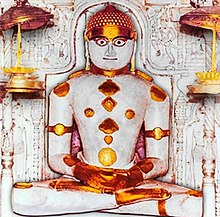
Rishabhanatha (Devanagari: ऋषभनाथ), also Rishabhadeva (Devanagari: ऋषभदेव, Ṛṣabhadeva), Rishabha (Devanagari: ऋषभ, Ṛṣabha) or Ikshvaku (Devanagari: इक्ष्वाकु, Ikṣvāku), is the first tirthankara (Supreme preacher) of Jainism. He was the first of twenty-four teachers in the present half-cycle of time in Jain cosmology and called a "ford maker" because his teachings helped one cross the sea of interminable rebirths and deaths. The legends depict him as having lived millions of years ago. He was the spiritual successor of Sampratti Bhagwan, the last Tirthankara of the previous time cycle. He is also known as Ādinātha (lit. "first Lord"), as well as Adishvara (first Jina), Yugadideva (first deva of the yuga), Prathamarajeshwara (first God-king) and Nabheya (son of Nabhi). He is also known as Ikshvaku, establisher of the Ikshvaku dynasty. Along with Mahavira, Parshvanath, Neminath, and Shantinath, Rishabhanatha is one of the five Tirthankaras that attract the most devotional worship among the Jains.
According to traditional accounts, he was born to king Nabhi and queen Marudevi in the north Indian city of Ayodhya, also called Vinita. He had two wives, Sumangalā and Sunandā. Sumangalā is described as the mother of his ninety-nine sons (including Bharata) and one daughter, Brahmi. Sunandā is depicted as the mother of Bahubali and Sundari. The sudden death of Nilanjana, one of the dancers sent by Indra in his courtroom, reminded him of the world's transitory nature, and he developed a desire for renunciation. (Full article...) -
Image 18Vaikuntha Chaturmukha, 9th century, Kashmir in Los Angeles County Museum of Art
Vaikuntha Chaturmurti or Vaikuntha Vishnu is a four-headed aspect of the Hindu god Vishnu, mostly found in Nepal and Kashmir (northern part of the Indian subcontinent). The icon represents Vishnu as the Supreme Being. He has a human head, a lion head, a boar head and a fierce head. Sometimes, even three-headed but aspects of Vishnu where the fierce rear head is dropped are considered to represent Vaikuntha Chaturmurti. Though iconographical treatises describe him to eight-armed, he is often depicted with four. Generally, Vaikuntha Chaturmurti is shown standing but sometimes he is depicted seated on his vahana (mount) Garuda.
The concept of a four-headed Vishnu first appears in the Hindu epic Mahabharata, but the complete iconography was first found in a 5th-century Pancharatra text. The icon reflects influences from the Gupta period and the Gandhara architectural tradition. While as per one interpretation, the animal heads represent Vishnu's avatar Narasimha (lion-headed man) and Varaha (boar), another theory based on Pancharatra texts relates the four heads to the Chaturvyuha: Vasudeva (Krishna), Samkarshana (Balarama), Pradyumna and Aniruddha – four vyuhas (manifestations) of Vishnu. A cult centered on Vaikuntha Chaturmurti developed in Kashmir in the 8–12th century, when the deity also enjoyed royal patronage in the region. The Lakshmana Temple of Khajuraho suggests his worship in the Chandela kingdom (Central India) in the 10th century. (Full article...) -
Image 19
A postural yoga show in Kolkata, January 2012. Postures in the display include Chakrasana (front), Natarajasana (back), Rajakapotasana (middle row), and Padmasana (top).
Postural yoga began in India as a variant of traditional yoga, which was a mainly meditational practice; it has spread across the world and returned to the Indian subcontinent in different forms. The ancient Yoga Sutras of Patanjali mention yoga postures, asanas, only briefly, as meditation seats. Medieval Haṭha yoga made use of a small number of asanas alongside other techniques such as pranayama, shatkarmas, and mudras, but it was despised and almost extinct by the start of the 20th century. At that time, the revival of postural yoga was at first driven by Indian nationalism. Advocates such as Yogendra and Kuvalayananda made yoga acceptable in the 1920s, treating it as a medical subject. From the 1930s, the "father of modern yoga" Krishnamacharya developed a vigorous postural yoga, influenced by gymnastics, with transitions (vinyasas) that allowed one pose to flow into the next.
Krishnamacharya's pupils K. Pattabhi Jois and B. K. S. Iyengar brought yoga to the West and developed it further, founding their own schools and training yoga teachers. Once in the West, yoga quickly became mixed with other activities, becoming less spiritual and more energetic as well as commercial. (Full article...) -
Image 20Muthu (transl. Pearl) is a 1995 Indian Tamil-language masala film written and directed by K. S. Ravikumar, and produced by Kavithalayaa Productions. The film stars Rajinikanth and Meena, with Sarath Babu, Radha Ravi, Senthil, Vadivelu, Jayabharathi, Subhashri and Ponnambalam all acting in supporting roles. It is a remake of the Malayalam film Thenmavin Kombath (1994). The film revolves around a zamindar and his worker falling in love with the same woman who, unknown to the zamindar, loves the worker exclusively.
After Rajinikanth narrated the outline of Thenmavin Kombath, he told Ravikumar to develop the screenplay of the remake without watching the original film. Although largely written to suit the tastes of Tamil-speaking audiences, the remake retains the core premise of the original, while adding new plot details and characters. Ashok Rajan acted as the film's cinematographer. Principal photography began in June 1995 and took place in Mysore, Madras and Kerala. The film was edited by K. Thanikachalam and the music composed by A. R. Rahman, with lyrics written by Vairamuthu. (Full article...) -
Image 21Cornelia Sorabji at the Braemar Gathering in 1924
Cornelia Sorabji (15 November 1866 – 6 July 1954) was an Indian lawyer, social reformer and writer. She was the first female graduate from Bombay University, and the first woman to study law at Oxford University. Returning to India after her studies at Oxford, Sorabji became involved in social and advisory work on behalf of the purdahnashins, women who were forbidden to communicate with the outside male world, but she was unable to defend them in court since, as a woman, she did not hold professional standing in the Indian legal system. Hoping to remedy this, Sorabji presented herself for the LLB examination of Bombay University in 1897 and the pleader's examination of Allahabad High Court in 1899. She became the first female advocate in India but would not be recognised as a barrister until the law which barred women from practising was changed in 1923.
She was involved with several social service campaigning groups, including the National Council for Women in India, the Federation of University Women, and the Bengal League of Social Service for Women. She opposed the imposition of Western perspectives on the movement for women's change in India, and took a cautious approach to social reform, opposing rapid change. Sorabji believed that until all women were educated, political reform would not be of genuine lasting value. She supported the British Raj, and purdah for upper-caste Hindu women, and opposed Indian self-rule. Her views prevented her obtaining the support needed to undertake later social reforms. Sorabji authored multiple publications, which were influential in the early 20th century. (Full article...) -
Image 22
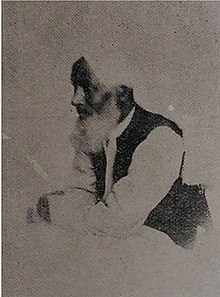
Mahmud Hasan Deobandi (also known as Shaykh al-Hind; 1851–1920) was an Indian Muslim scholar and an activist of the Indian independence movement, who co-founded the Jamia Millia Islamia University and launched the Silk Letter Movement for the freedom of India. He was the first student to study at the Darul Uloom Deoband seminary. His teachers included Muhammad Qasim Nanawtawi and Mahmud Deobandi, and he was authorized in Sufism by Imdadullah Muhajir Makki and Rashid Ahmad Gangohi.
Hasan served as the principal of the Darul Uloom Deoband and founded organisations such as the Jamiatul Ansar and the Nizaratul Maarif. He wrote a translation of the Quran in Urdu and authored books such as Adilla-e-Kāmilah, Īzah al-adillah, Ahsan al-Qirā and Juhd al-Muqill. He taught hadith at the Darul Uloom Deoband and copyedited the Sunan Abu Dawud. His major students included Ashraf Ali Thanwi, Anwar Shah Kashmiri, Hussain Ahmad Madani, Kifayatullah Dehlawi, Sanaullah Amritsari and Ubaidullah Sindhi. (Full article...) -
Image 23Chennai Super Kings (CSK) is an Indian professional T20 cricket franchise based in Chennai, Tamil Nadu. The team competes in the Indian Premier League (IPL) and was one of the eight franchises incorporated when the league was established in 2008. The team plays its home matches at the M. A. Chidambaram Stadium and is owned by Chennai Super Kings Cricket.
The Super Kings is the joint-most successful IPL franchise, having won five IPL titles (along with Mumbai Indians). In the IPL, it has appeared in a 10 finals and qualified for the playoff stages 12 times, the most amongst the IPL teams. The franchise has also won the Champions League Twenty20 twice in 2010 and 2014. The team is currently captained by Ruturaj Gaikwad and coached by Stephen Fleming. (Full article...) -
Image 24

The 1998 North Indian Ocean cyclone season was an active season in annual cycle of tropical cyclone formation. The season has no official bounds but cyclones tend to form between April and December. These dates conventionally delimit the period of each year when most tropical cyclones form in the northern Indian Ocean. There are two main seas in the North Indian Ocean—the Bay of Bengal to the east of the Indian subcontinent and the Arabian Sea to the west of India. The official Regional Specialized Meteorological Centre in this basin is the India Meteorological Department (IMD), while the Joint Typhoon Warning Center releases unofficial advisories. An average of four to six storms form in the North Indian Ocean every season with peaks in May and November. Cyclones occurring between the meridians 45°E and 100°E are included in the season by the IMD.
With eleven depressions and eight tropical cyclones, this was one of the most active seasons in the ocean along with 1987, 1996, and 2005. The season caused a large loss of life, most of which was from one storm. Over 10,000 people were killed in India when Tropical Cyclone 03A brought a 4.9-metre (16-foot) storm surge to the Kathiawar Peninsula, inundating numerous salt mines. Total damages from the storm amounted to Rs. 120 billion (US$3 billion). Tropical Cyclone 01B killed at least 26 people and left at least 4,000 fishermen missing in eastern Bangladesh on May 20. A short lived depression in mid-October killed 122 people after triggering severe flooding in Andhra Pradesh. In November, Tropical Cyclone 06B killed six people and caused property damage worth BTN 880 million (US$20.7 million) in eastern India. An additional 40 people were killed and 100 fishermen were listed as missing after Tropical Cyclone 07B affected Bangladesh. (Full article...) -
Image 25Nartanasala (transl. The dance pavilion) is a 1963 Indian Telugu-language Hindu mythological film directed by Kamalakara Kameswara Rao and written by Samudrala Sr. It stars N. T. Rama Rao, Savitri, S. V. Ranga Rao, and Relangi while Mukkamala, Mikkilineni and Dandamudi Rajagopal play supporting roles among others. Susarla Dakshinamurthi composed the film's soundtrack and background score. M. A. Rahman and S. P. S. Veerappa served as the cinematographer and editor respectively. T. V. S. Sarma was the film's art director. The film was produced by actress C. Lakshmi Rajyam and her husband C. Sridhar Rao under the Rajyam Pictures banner.
Based on the Virata Parva of the Indian epic Mahabharata, Nartanasala focused on the trials of the Pandavas in the last year of their exile. The Pandavas assumed different identities and lived incognito in Virata's Matsya Kingdom. The Kauravas wished to reveal the Pandavas' real identities so that they would repeat another exile of 13 years in a cyclic fashion. The issues faced by the Pandavas and their wife Draupadi at Matsya due to various factors, notably Virata's brother-in-law Kichaka form the rest of the story. (Full article...)
News
- 20 January 2025 – 2024 Kolkata rape and murder
- A court in Kolkata, India, sentences a 33-year-old police volunteer to life in prison for the August 2024 rape and murder of a medical trainee. (DW)
- 17 January 2025 – Naxalite–Maoist insurgency
- Twelve Naxalites are killed in a police raid in Bijapur, Chhattisgarh, India. (Al Jazeera)
- 16 January 2025 – 2025 in spaceflight
- The twin satellites SDX01 and SDX02 of the SpaDeX mission, launched in December by the Indian Space Research Organisation, successfully conduct India's first spacecraft docking, with India becoming the fourth country to successfully dock a spacecraft after the United States, Russia, and China. (BBC News)
- 11 January 2025 – 2024–25 South-West Indian Ocean cyclone season
- France places the Indian Ocean island of Mayotte on red alert due to approaching Tropical Cyclone Dikeledi, roughly one month after the French overseas department was devastated by Cyclone Chido. (Reuters)
- 8 January 2025 – Deadly human stampedes in Hindu temples
- Six people are killed and over forty others are injured in a stampede at the Hindu Venkateswara Temple in Tirupati, Andhra Pradesh, India. (AP) (Business Today)
Did you know...
- ... that Wankaner's Ranjit Vilas Palace in Gujarat, India, features Venetian Gothic, Italianate, Mughal and Rajput styles?
- ... that Sir Srinivas Varadachariar was the first Indian chief justice of the Federal Court of India?
- ... that a viral video by an Indian influencer resulted in the sugar content of Bournvita being cut by almost 15 percent?
- ... that a painting by the artist Bichitr shows an Indian emperor preferring a Sufi saint over the king of England and the Ottoman sultan?
- ... that Cusrow Baug in Mumbai had only a few tenants in the 1950s even at a low rent of 40 rupees per month?
- ... that singer Mohinder Kaur Bhamra encouraged British Indian women to join in party celebrations at a time when they were typically excluded?
Topics related to India
Timeline of Indian history, Indus Valley Civilisation, Dholavira, Science and technology in ancient India, Meluhha, Aryan invasion theory, Out of India theory, Greek conquests in India, Indian maritime history, Maurya Empire, Ashoka, Shunga Empire, Hoysala Empire, Vijayanagara, Satavahana dynasty, Indo-Greek Kingdom, Indo-Scythians, Indo-Parthian Kingdom, Kushan Empire, Western Satraps, Gupta Empire, Chola dynasty, Pala Empire, Islamic incursions in India, Mughal Empire, Maratha Empire, British Raj, East India Company, Governor-General, Viceroy, War of Independence, 1857, Indian independence movement, Indian National Army, Azad Hind, Quit India Movement, Partition of India, History of Republic of India, Non-Aligned Movement, Sino-Indian War, Indo-Pakistani War of 1947–1948, Indo-Pakistani War of 1965, Indo-Pakistani War of 1971, Kargil War, 2001–02 India–Pakistan standoff, Military, Demographic
Law, Hindu law, Constitution, Political parties (Indian National Congress, Bharatiya Janata Party), Foreign relations, Elections, Political divisions, Reservation in India
Government agencies, Legislative branch (Lok Sabha, Rajya Sabha) Executive branch (President & Vice President, Prime Minister & Deputy Prime Minister, Cabinet Ministers, Cabinet Secretary, Election Commission, Foreign Minister; Law enforcement: CBI, CID, Intelligence: IB, RAW), Directorate General of Income Tax Investigation Judicial branch (Supreme Court), Armed Forces (Army, Navy, Air Force, Border Security Force, Coast Guard)
Himalayas, Western Ghats, Eastern Ghats, Indo-Gangetic Plain, Deccan Plateau, Thar Desert, Ganges, Rann of Kutch, Brahmaputra River, Northeast India; Mountains, Valleys, Islands, Rivers; States and union territories, Cities, Districts, Regions, Fauna, Flora
Rupee, Bombay Stock Exchange, National Stock Exchange, Standard of living, Companies, Reserve Bank of India, Energy policy (Solar, Wind, Nuclear), Tourism, Transport (Expressways, Rail transport, Auto rickshaw),
Languages, Standard of living, Religion
Music (Carnatic, Hindustani, Indi-pop), Dance, Languages, Literature, Architecture, Film & TV, Cuisine, Holidays, Folklore, Education, Media, Indian martial arts
Indian Council of Agricultural Research (ICAR), Indian Institute of Astrophysics, National Centre for Software Technology, AIIMS, IISc, IIT, NIT, BITS-Pilani, INRegistry, Indian numbering system, Indian Space Research Organisation, National Internet Exchange of India, ICRISAT, International Institute of Information Technology, Hyderabad
Indian English, Indian nationality law, Numbering system, Indian Space Research Organisation, Telecommunications, National Highways Development Project, Flag, Vehicle registration plates, Indian nationalism, Metrication in India
Categories
Related portals
Religions in India
Indian Subcontinent
Other countries
Wikipedias in Indian languages
- অসমীয়া (Assamese)
- বাংলা (Bengali)
- भोजपुरी (Bhojpuri)
- বিষ্ণুপ্রিয়া মণিপুরী (Bishnupriya Manipuri)
- गोंयची कोंकणी / Gõychi Konknni (Konkani)
- ગુજરાતી (Gujarati)
- हिन्दी (Hindi)
- ಕನ್ನಡ (Kannada)
- कॉशुर/كشميري (Kashmiri)
- मैथिली (Maithili)
- മലയാളം (Malayalam)
- मराठी (Marathi)
- नेपाली (Nepali)
- नेपाल भाषा
- (Newari)
- ଓଡ଼ିଆ (Odiya)
- ਪੰਜਾਬੀ (Punjabi)
- पालि (Pali)
- संस्कृत (Sanskrit)
- ᱥᱟᱱᱛᱟᱲᱤ (Santali)
- سنڌي (Sindhi)
- தமிழ் (Tamil)
- తెలుగు (Telugu)
- ತುಳು (Tulu)
- اردو (Urdu)
Associated Wikimedia
The following Wikimedia Foundation sister projects provide more on this subject:
-
Commons
Free media repository -
Wikibooks
Free textbooks and manuals -
Wikidata
Free knowledge base -
Wikinews
Free-content news -
Wikiquote
Collection of quotations -
Wikisource
Free-content library -
Wikiversity
Free learning tools -
Wikivoyage
Free travel guide -
Wiktionary
Dictionary and thesaurus
- Pages with Hindustani IPA
- Pages using the Phonos extension
- Pages including recorded pronunciations
- Pages with Hindi IPA
- Pages with Bengali IPA
- Pages with Tamil IPA
- Pages with Kannada IPA
- Portals with triaged subpages from June 2018
- All portals with triaged subpages
- Portals with no named maintainer
- Automated article-slideshow portals with 51–100 articles in article list
- Automated article-slideshow portals with 101–200 articles in article list
- Automated article-slideshow portals with 501–1000 articles in article list
- Wikipedia move-protected portals
- Redirect targets of redirected portals with existing subpages







